UCLA Psych 10 Midterm Review
1/122
There's no tags or description
Looks like no tags are added yet.
Name | Mastery | Learn | Test | Matching | Spaced |
|---|
No study sessions yet.
123 Terms
Structuralism
Wilhelm Wundt and Edward Titchener; focus was on how the mind is structured, studied consciousness by breaking it down into basic elements (via INTROSPECTION);
Functionalism
William James; focus was on what the mind does, or the function/purpose of behavior (especially EVOLUTIONARY FUNCTION/PURPOSE)
Behaviorism
Pavlov, Watson, Skinner, etc.; more scientific approach (less subjective like introspec.), reduced all behavior to STIMULUS-RESPONSE; movement away from cognition, towards OBSERVABLE behavior; OPPOSES COGNITIVE PSYCH.
Psychoanalysis
Sigmund Freud; focus was on UNCONSCIOUS PROCESSES/DESIRES, which they believed influenced behavior/personality (this and the previous two were late 19th-early 20th century)
Cognitive Psychology
Brenda Milner and Elizabeth Loftus; focus on cognition and the brain, mid 20th century to present; OPPOSES BEHAVIORISM
study mental processes and highlight the importance of these mental processes
Cross Cultural Psychology
focus on comparing and contrasting behavior in different human populations; generally studies based on WesternEducatedIndustrializedRichDemocratic (WEIRD) people
Placebo Effect (Bias)
when a person's physical or mental health appears to improve after taking a placebo or 'dummy' treatment
knowledge of receiving treatment affects behavior; SOLUTION: blind treatment (e.g. sugar pill)
Experimenter Bias
The researcher's expectations influence a participant's response/interpretation of observations; SOLUTION: Double Blind
Demand Characteristics (Bias)
The participant changes behavior because of what they believe about the study i.e. act different because they know they're being studied; (ex: Hawthorne Experiment, workers more productive when light manipulated, didnt wanna look lazy)
SOLUTION: Double Blind
Humans unique from other species because of the more developed ___________ in the brain.
frontal cortex; = greater cognition, reasoning, etc.
The brain develops in a way that resembles the evolution of the nervous system in other animals: The _______ brain and _____ brain develop first, while the ________ develops last.
hind brain, mid brain, prefrontal cortex last (planning, risk-taking, impulsivity) (develops later in life = teenagers + Phineas Gage poor judgment and inc. in risky/impulsive behavior)
Hindbrain
Controls info coming in and out of the spinal chord, controls life sustaining processes (e.g. breathing, etc.)
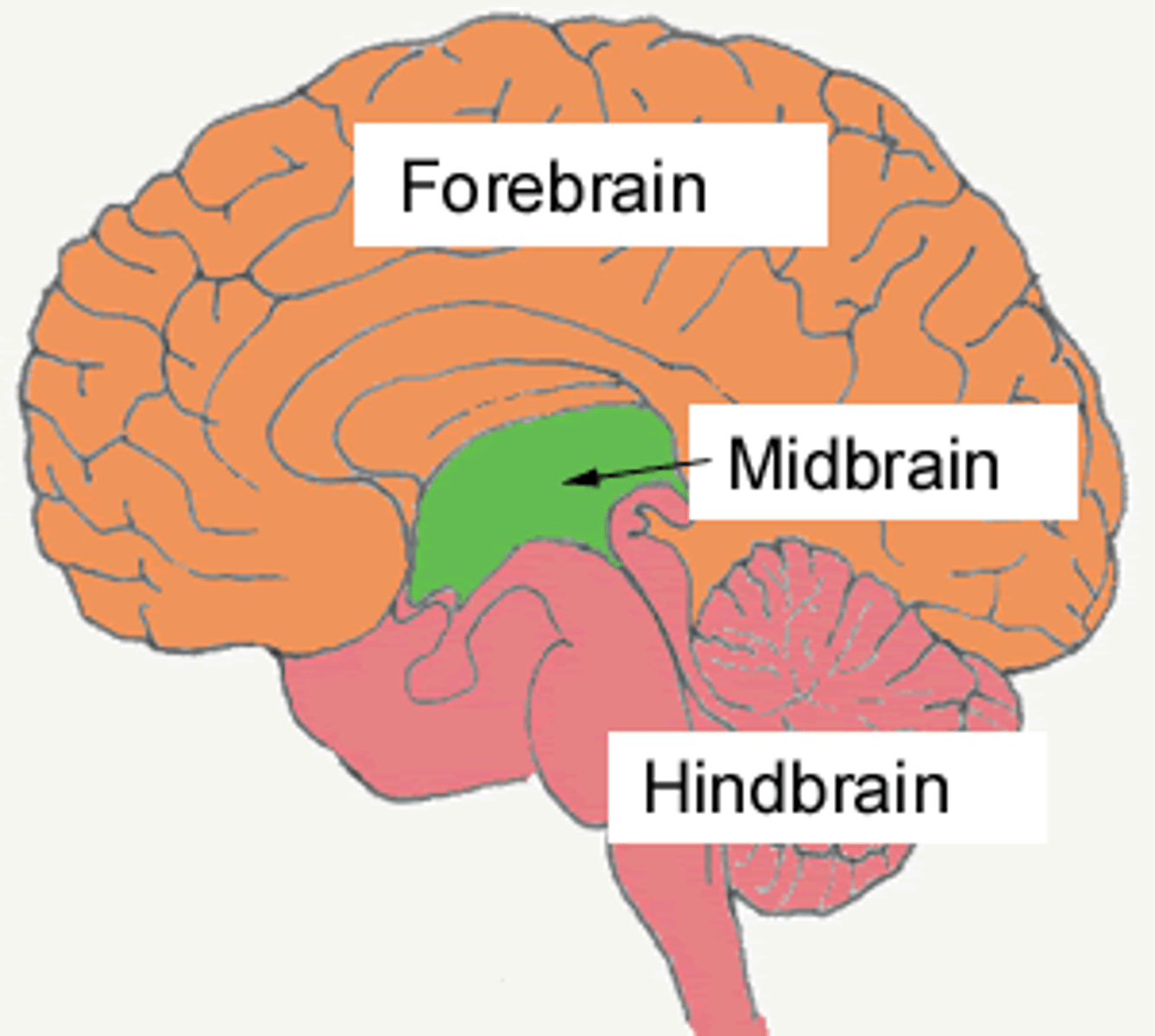
Pons
Hindbrain, "bridge over a PONdS;" connects the cerebellum and the rest of the brain
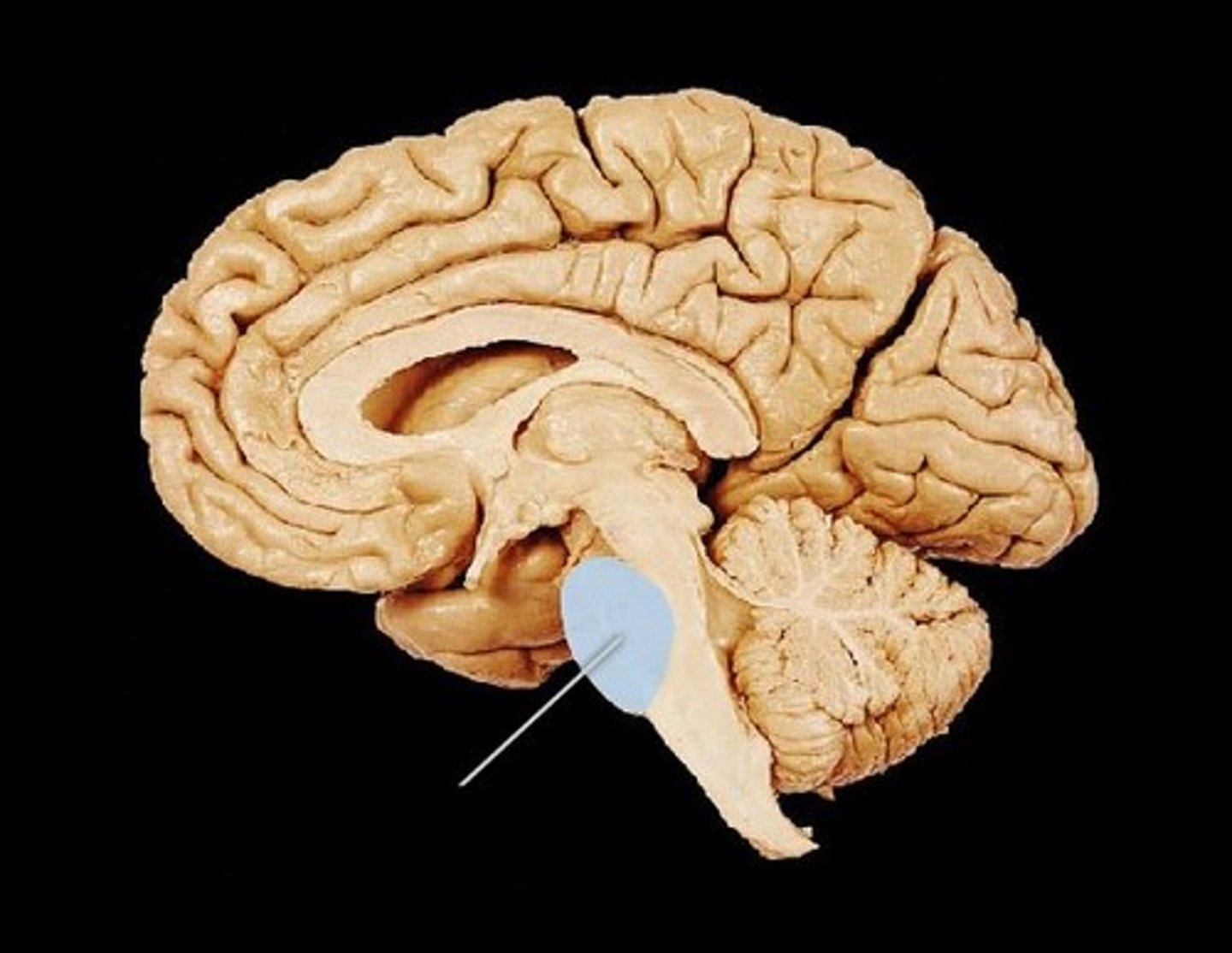
Reticular Formation
Hindbrain, "ReTICKular Formation;" controls sleep, wakefulness, arousal; nerve fibers on brain stem to connect the different parts of hindbrain
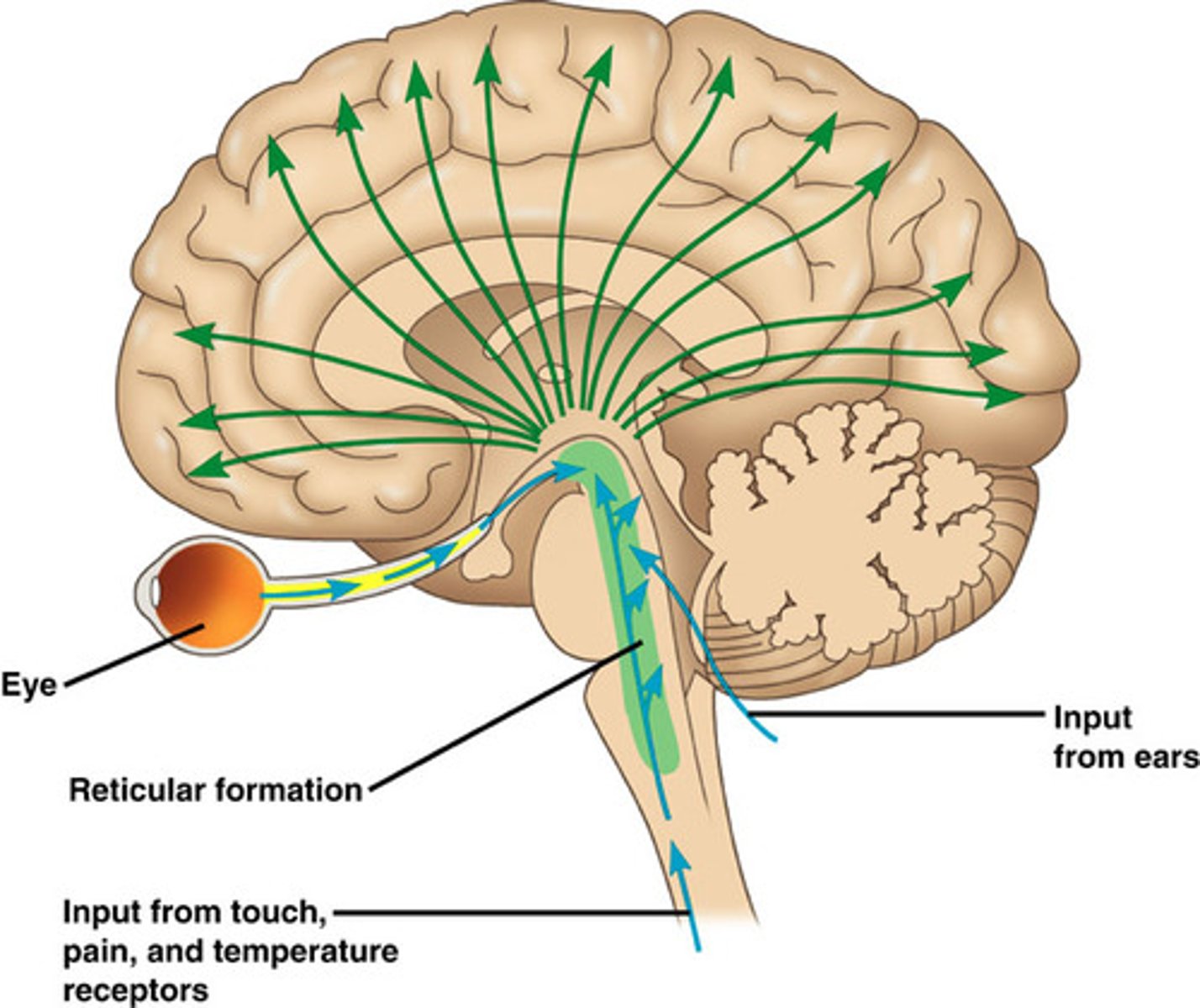
Medulla (Oblongata)
Hindbrain, "without MEdulla, ME DIE;" Middle of the brain stem, controls important core functions (e.g. heart rate, breathing, circulation, etc.)
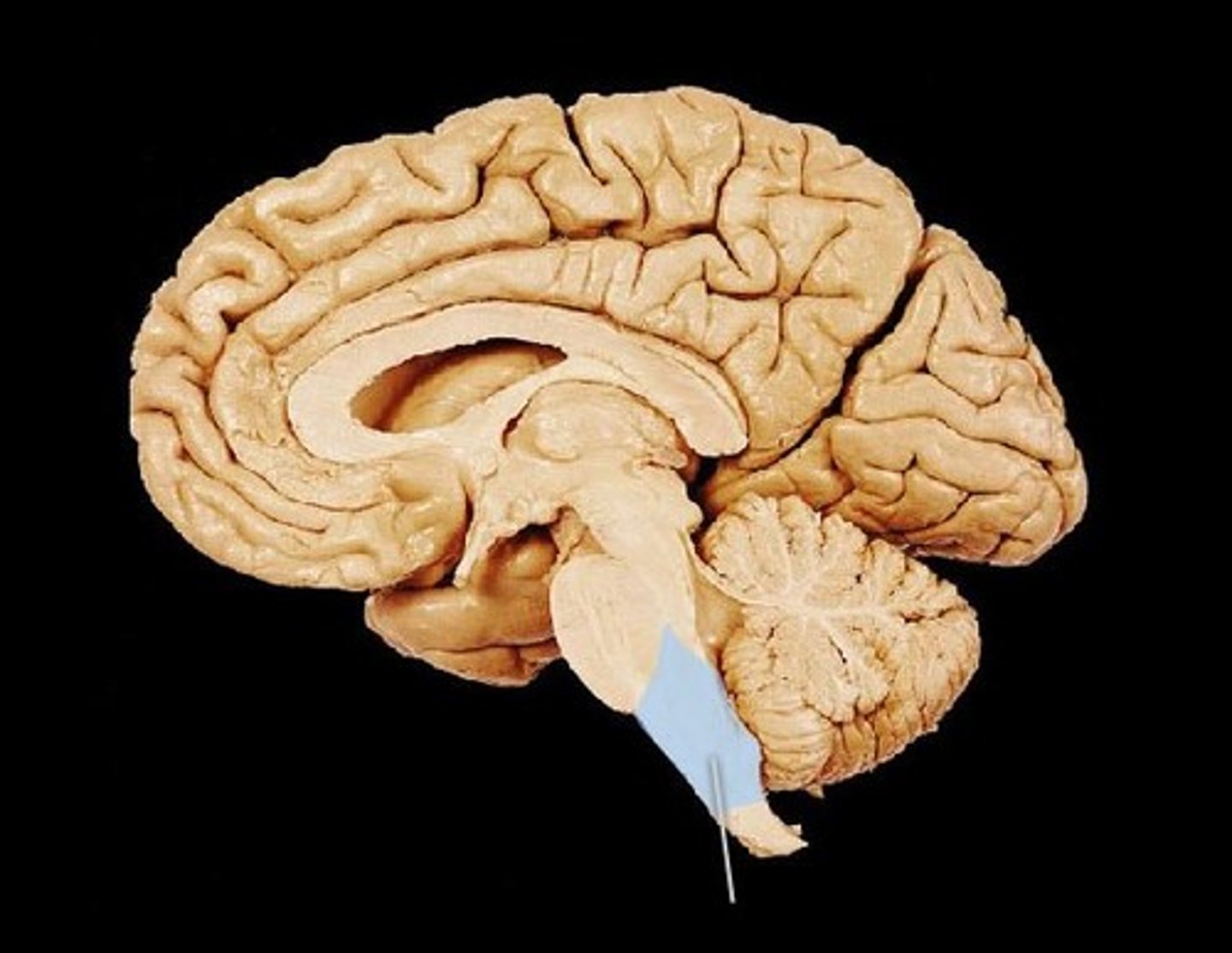
Cerebellum
Hindbrain, "I'm not drunk, my cerebellum is;" fine motor skills, coordination of movements, balance, etc.; the "little brain"
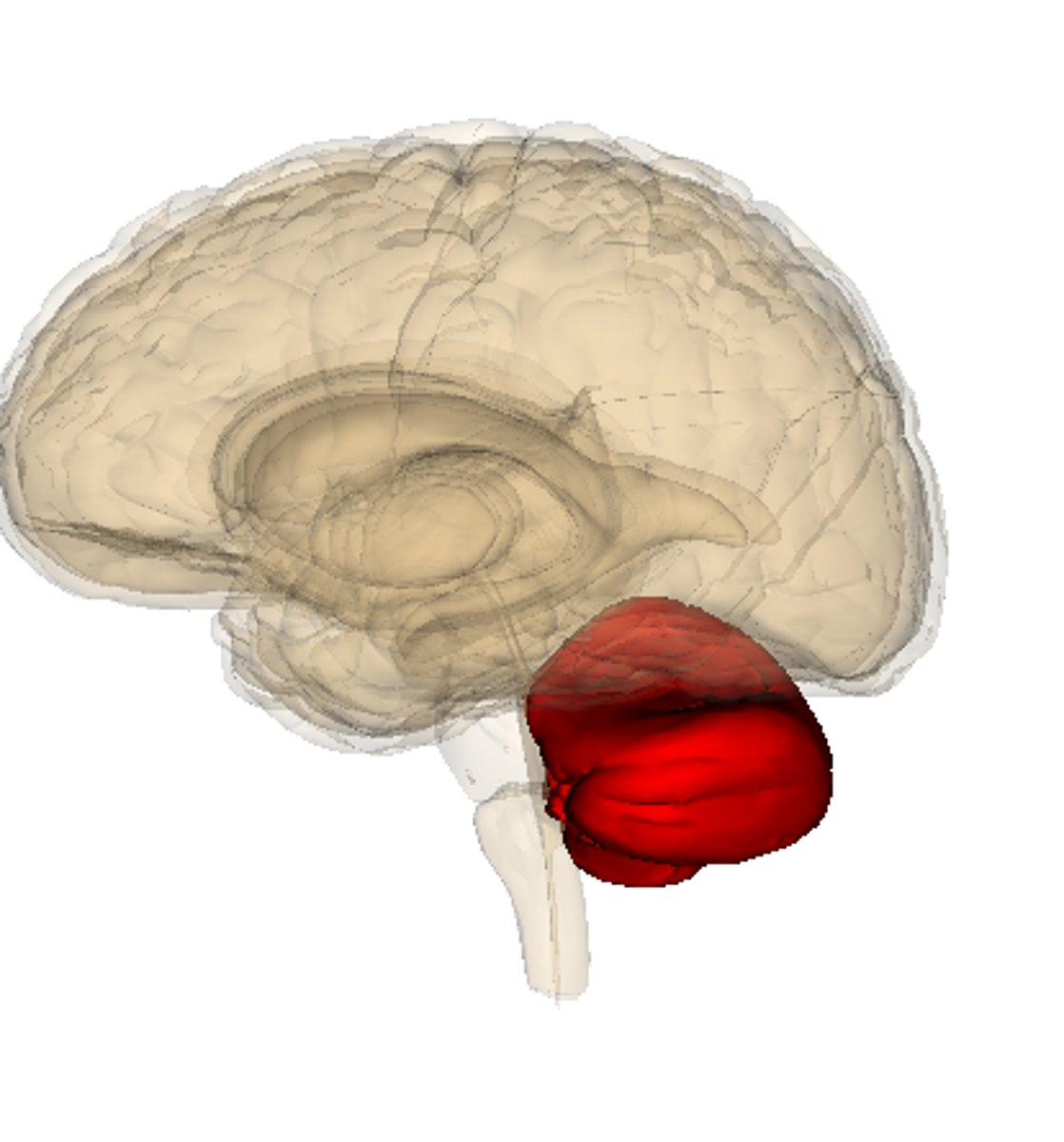
Midbrain
relay station between body and brain; important for coordination/motor movement, eye movement, auditory and visual processing; Main structures: Tectum and Tegmentum

Forebrain
sensory integration, control of voluntary movement, speech, abstract thought
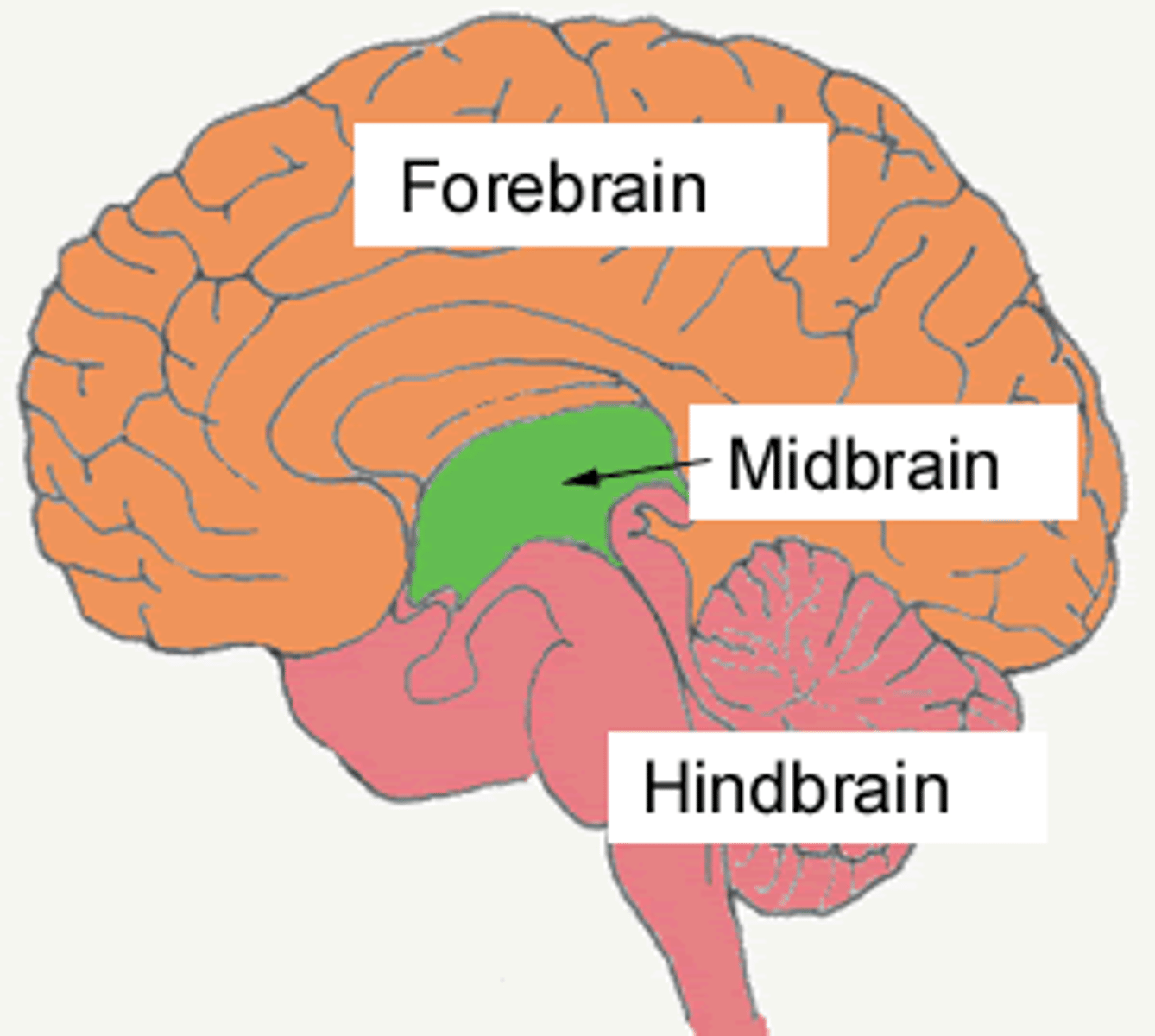
Hippocampus
"always REMEMBER the hippocampus;" Hippo = seahorse shape; ONE ON EACH SIDE OF BRAIN; memory consolidation, formation of memories, damage = amnesia (anterograde = new memories, retrograde = old/recollection)

Hypothalamus
"bad HYPOTHalamus = HYPOTHermia;" thermostat, regulates 4 Fs: Fighting, Fleeing, Feeding, "Mating"
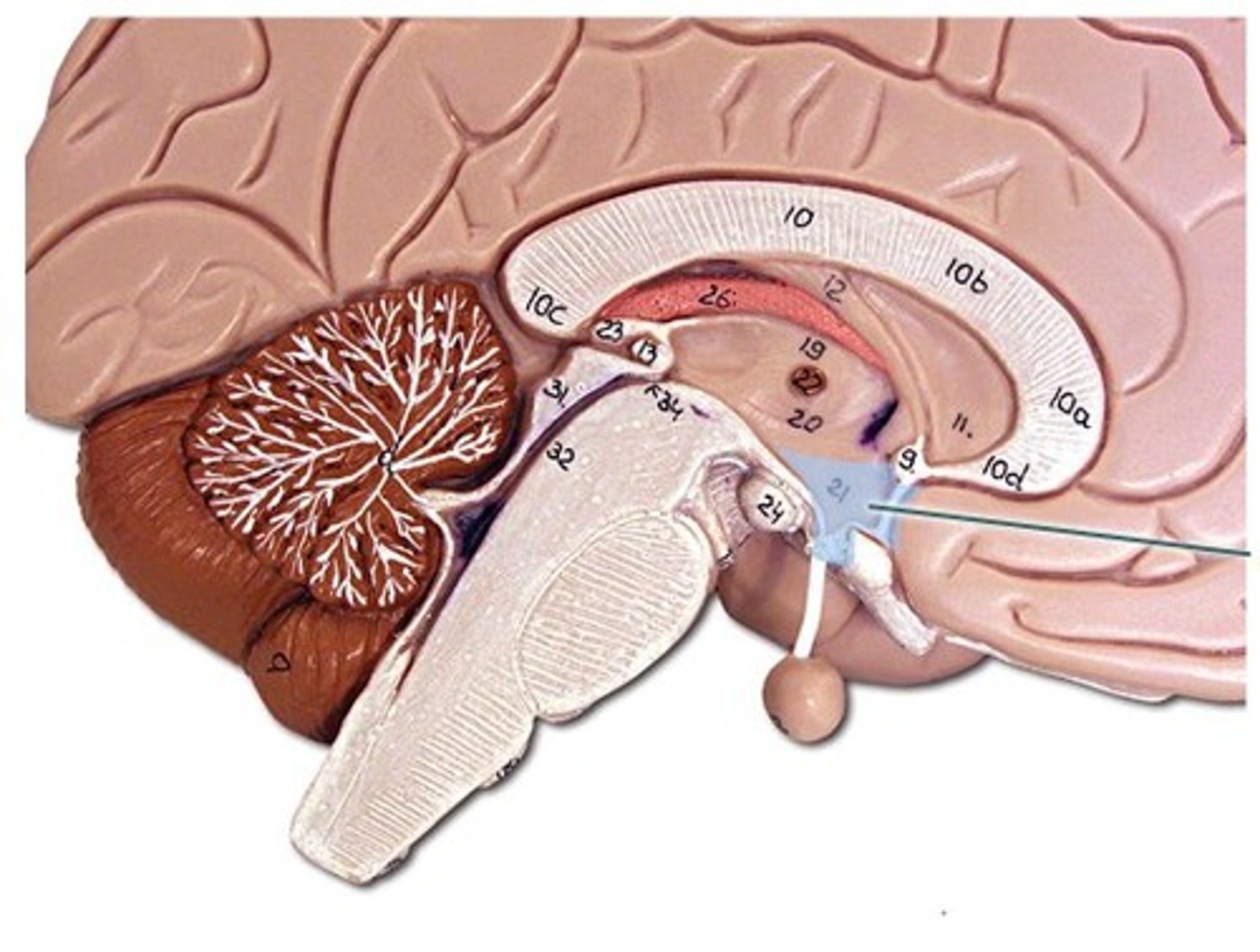
Thalamus
"the THalamus controls the Thenthes;" relay station for all senses (except smell); ONE ON EACH SIDE OF BRAIN

Basal Ganglia
"you use the Basal GANGlia to throw up GANG signs;" voluntary movement, "turn up the BASSil ganglia (looks like headphones + for auditory sense); ONE ON EACH SIDE OF BRAIN
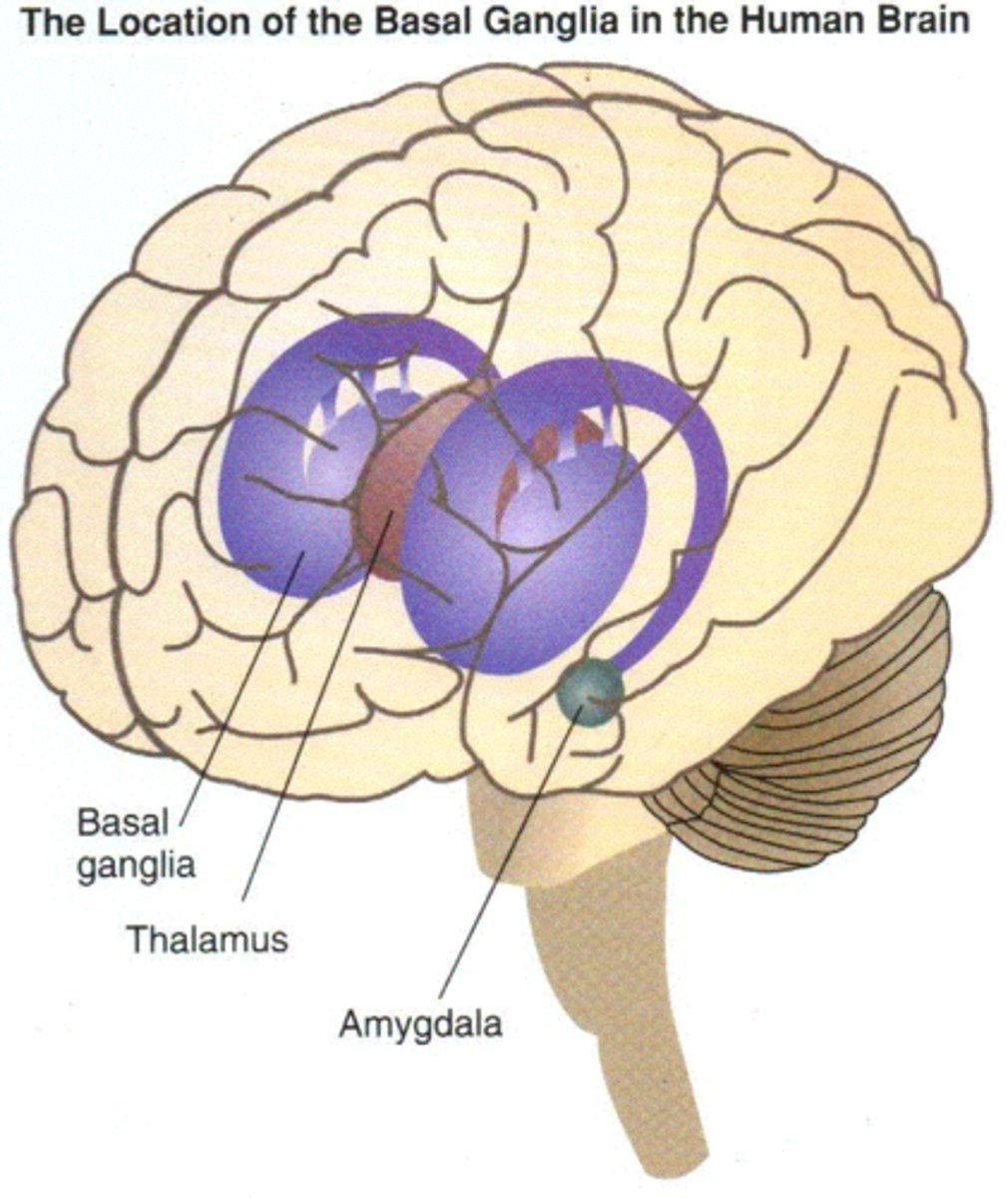
Amygdala
"AMY is emotional;" fear response, emotional stimuli, facial expression recognition; ONE ON EACH SIDE OF BRAIN
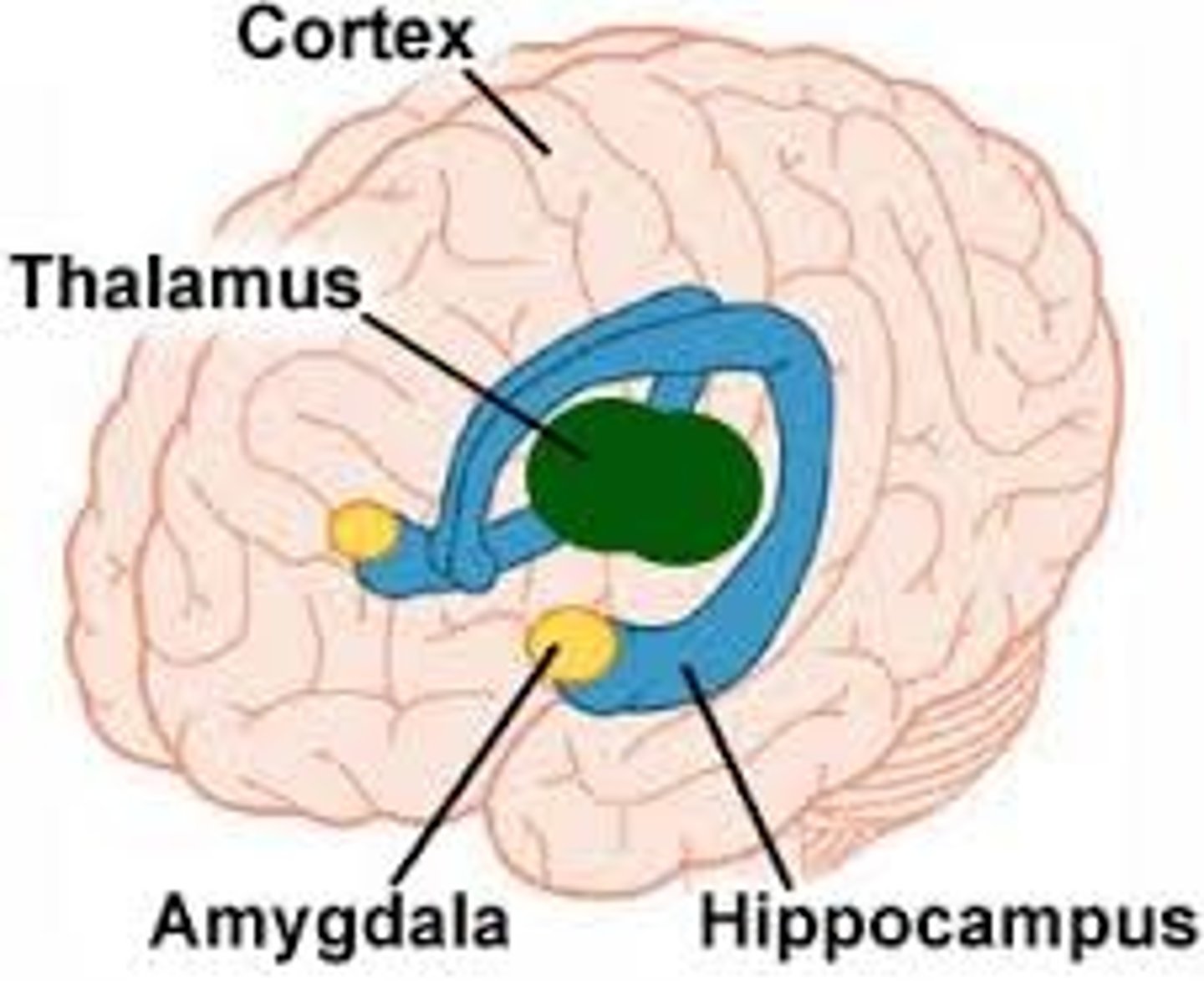
The Cerebral Cortex is the large, wrinkled area of the brain, it has a large SA that is folded so it can fit in a small volume of the skull. The (4) main lobes of the cerebral cortex are:
Frontal ("moving FORward;" motor movements, language, problem solving); Parietal ("Parietal used for PETting;" somatosensory cortex, processes sense of touch; contralaterally mapped), Occipital ("OCC = eyes;" visual processing), Temporal ("TEMPles = near the ears;" auditory processing )

Contralateral organization
opposite-side organization; left hemisphere controls right side of body and vice versa
somatosensory cortex
contralaterally mapped area at the front of the parietal lobes that registers and processes body touch and movement sensations, pain, visual and some auditory stimuli

Corpus Callosum
The structure that connects the two cerebral hemispheres.
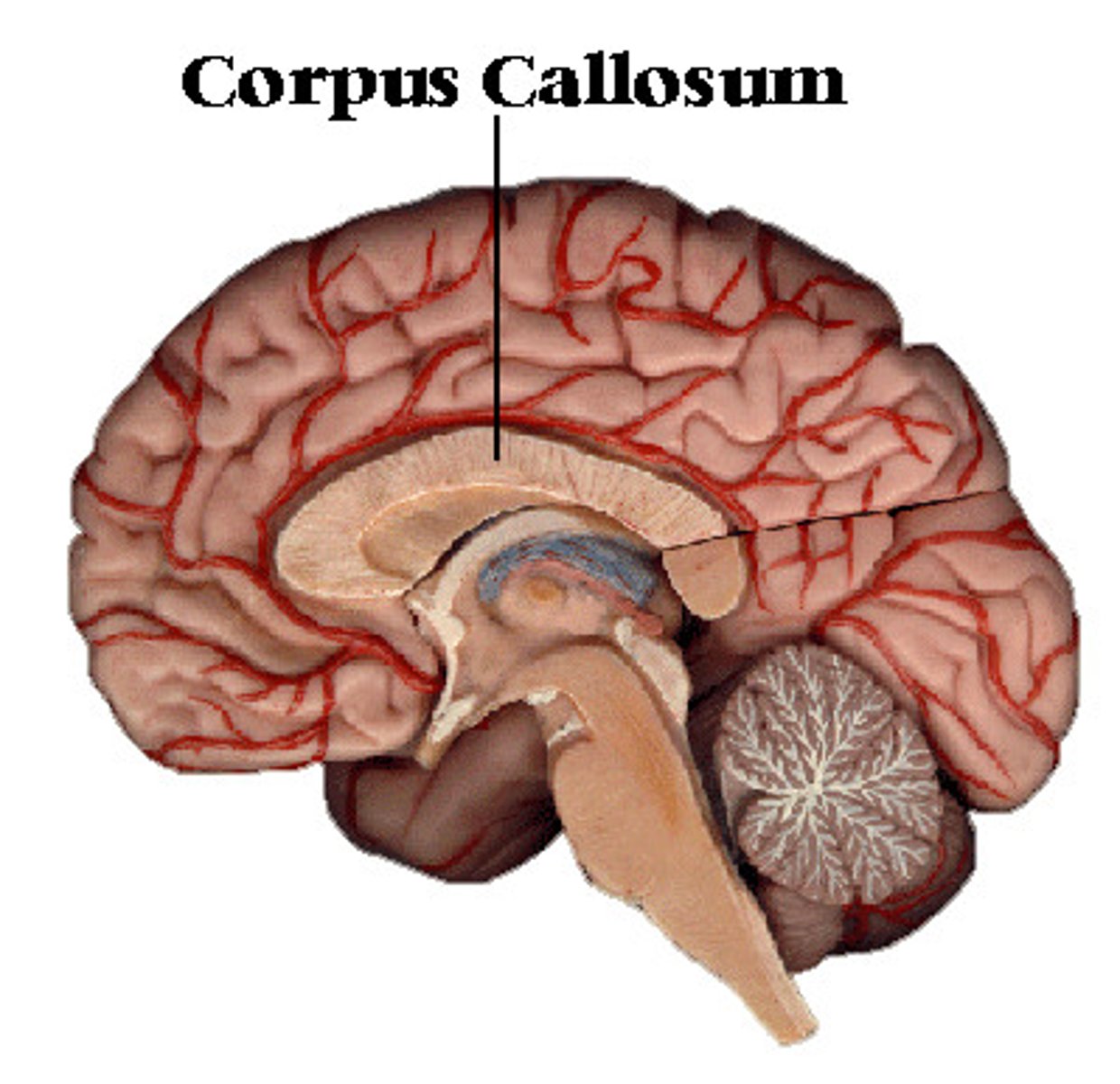
Brain is largely symmetrical, but there is some "lateralization"
variation in degree of lateralization (=localization of functions)
Broca's Area
located in frontal lobe, LEFT side near motor areas; language + speech production; often damaged in strokes; MOTOR AREAS DAMAGED = SPEECH PRODUCTION DAMAGED = COGNITIVE COMPONENT (COMPREHENSION) INTACT
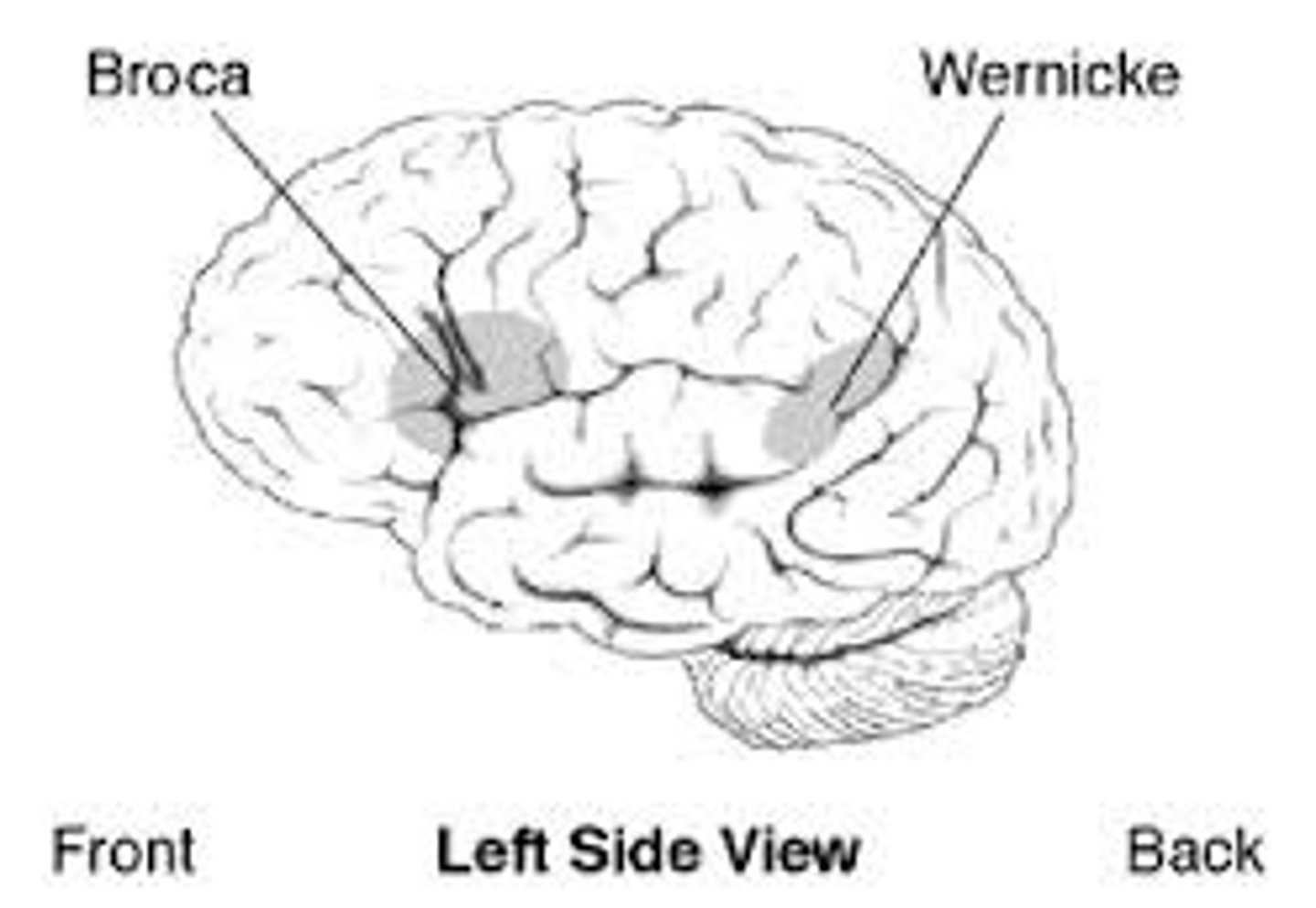
Wernicke's Area
located between parietal and temporal lobes on LEFT side; speech comprehension; damage to this area produces "word salad" (ie grammar correct but word choice is nonsensical) SENSORY AREA DAMAGED = TROUBLE UNDERSTANDING AND CORRECTLY EXPRESSING THOUGHTS = WORD SALAD
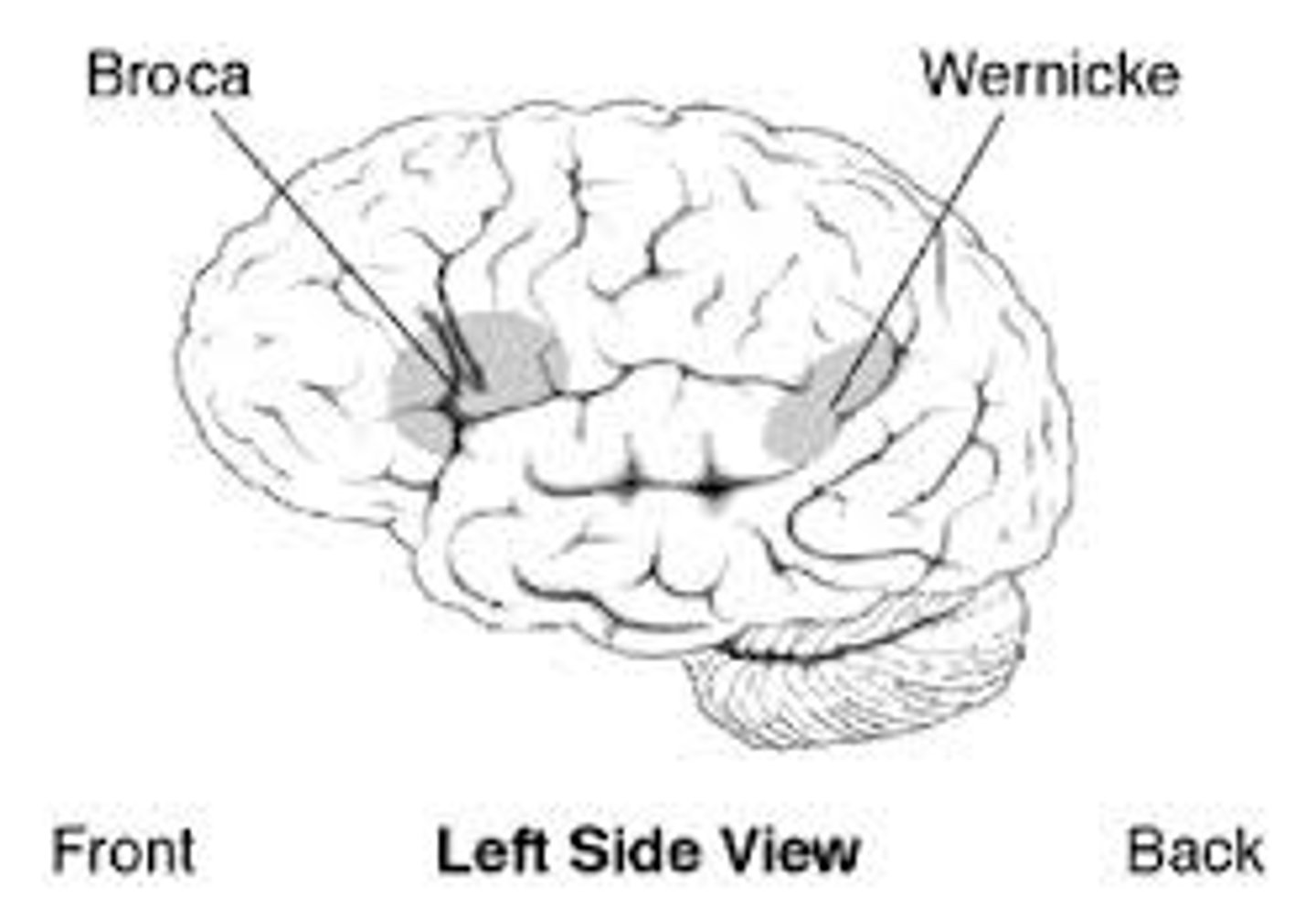
Speech Aphasia
the loss of ability to use or understand speech/language
Cell Body of neuron
coordinates information-processing tasks and keeps the cell alive; contains the nucleus of the neuron cells
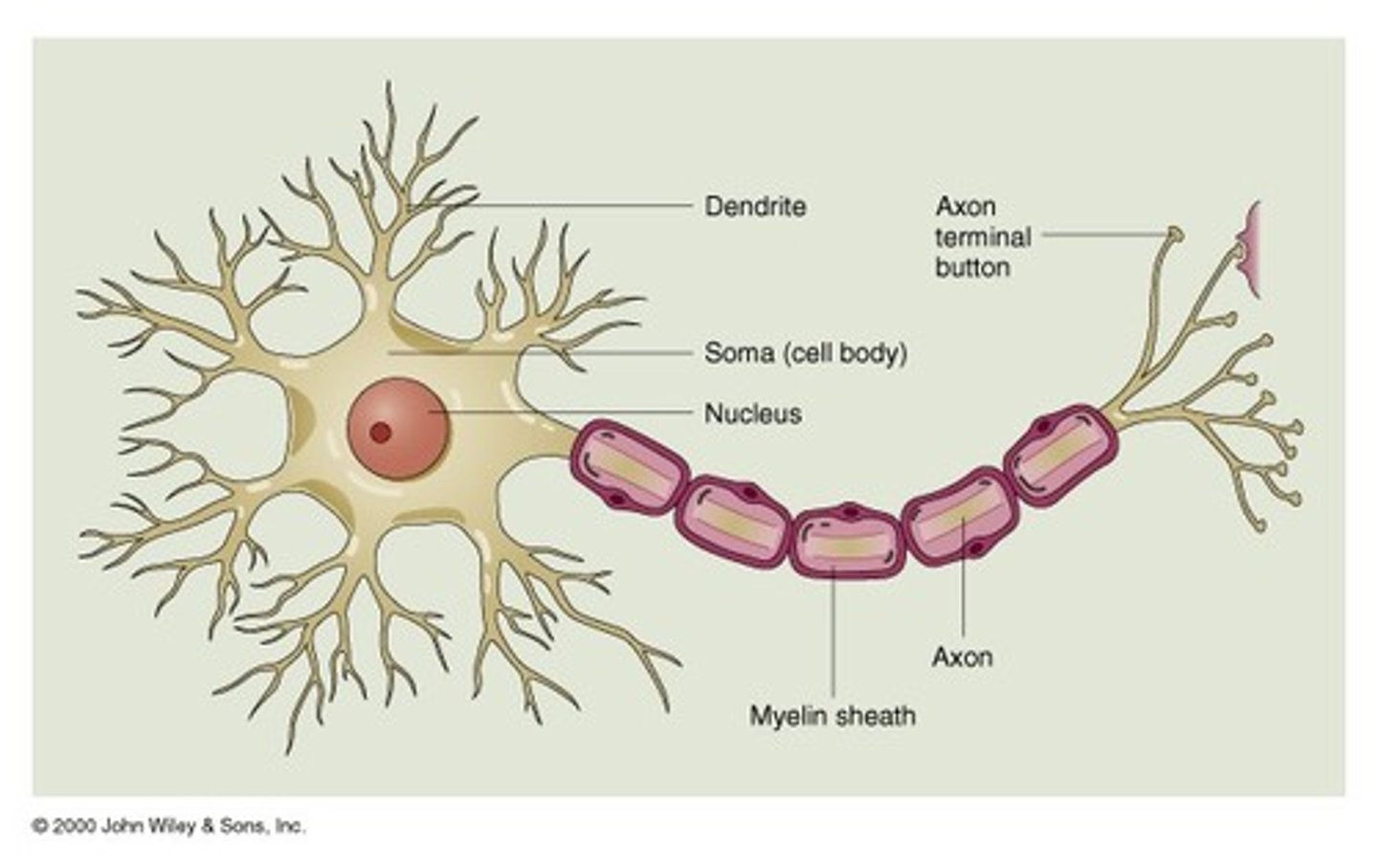
Dendrites of neuron
receive information from other neurons and relays it to the cell body
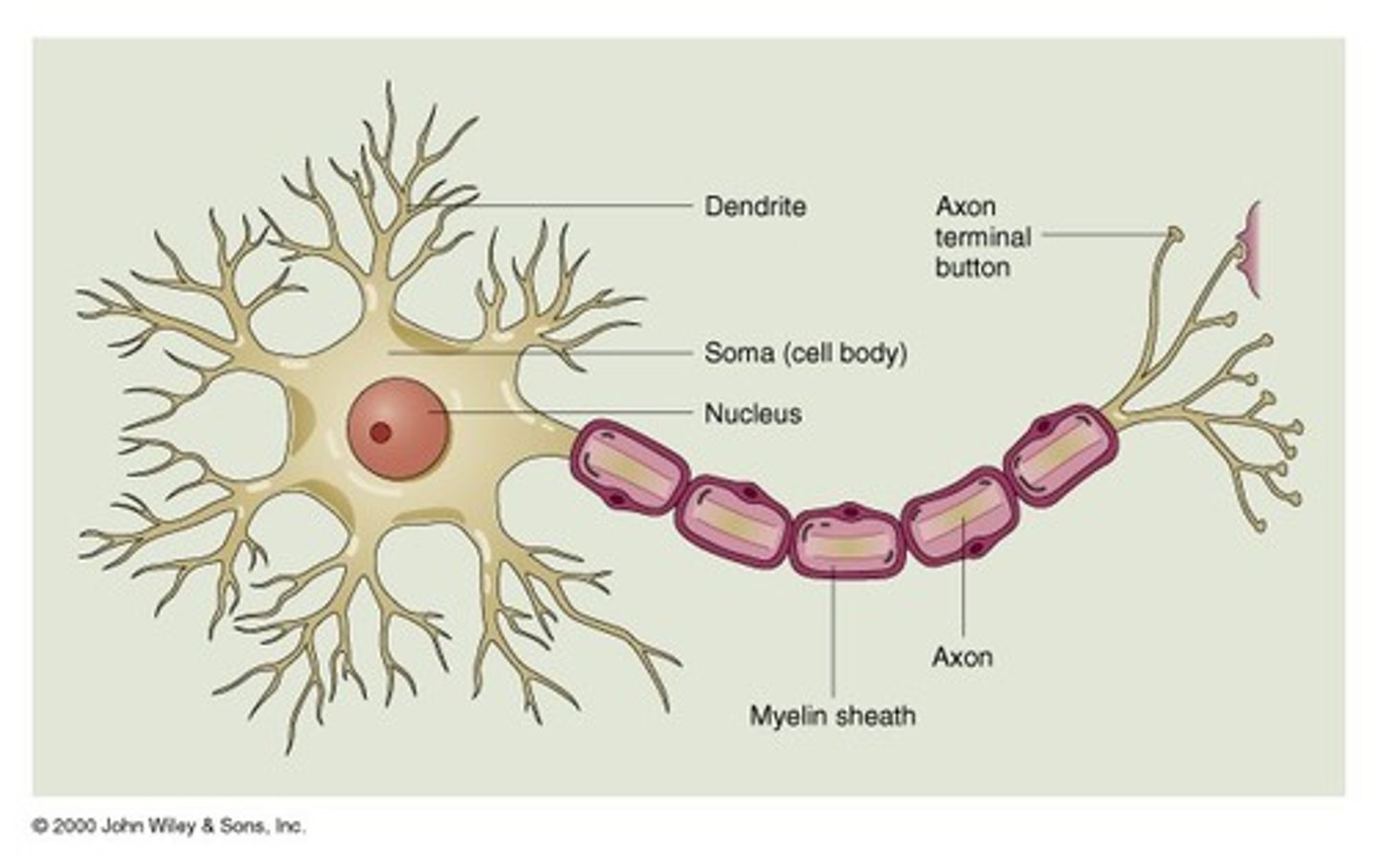
Axon of neuron
carries impulses/information away from the cell body; protected by myelin sheath
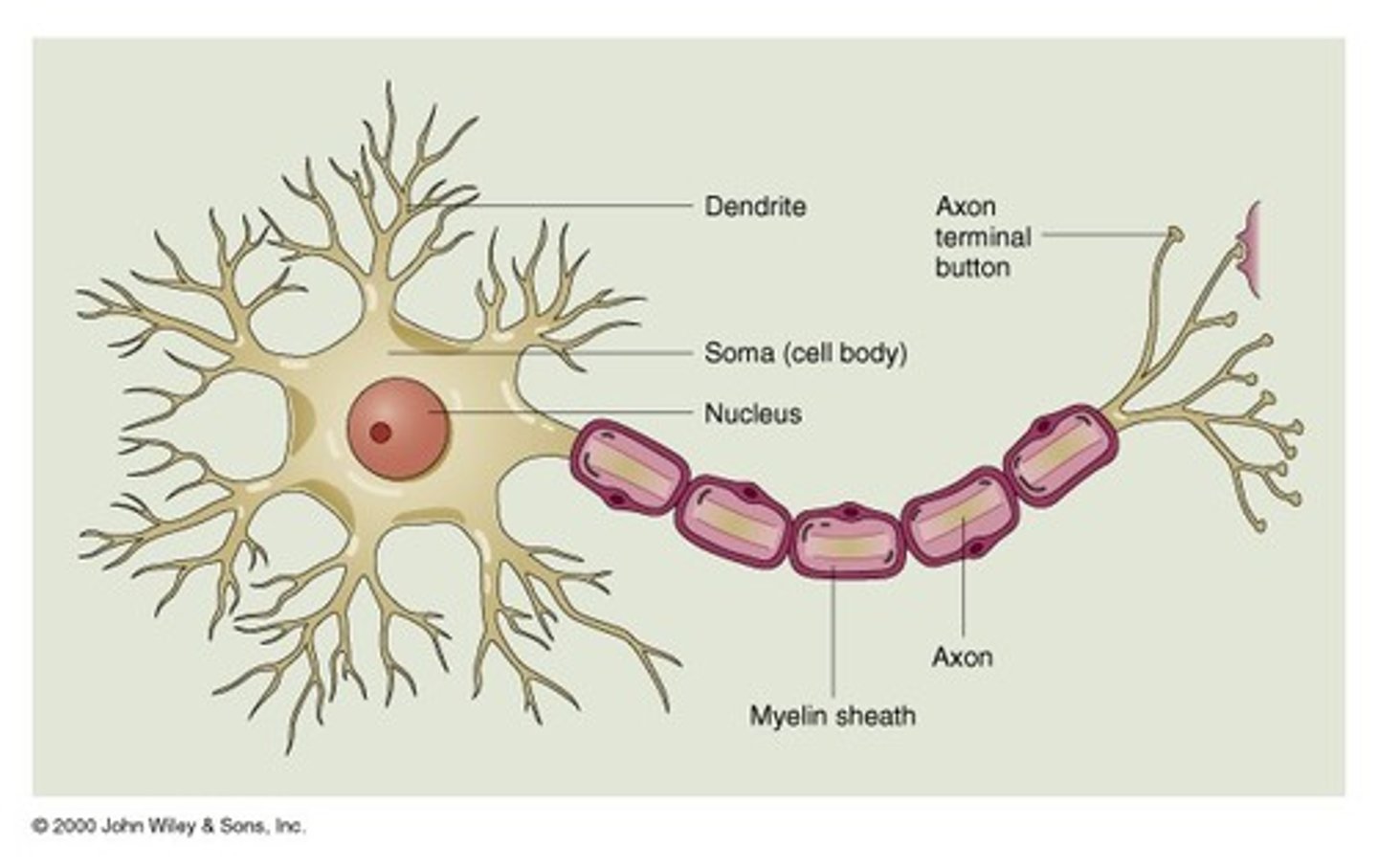
Myelin sheath of neuron
fatty tissue that insulates axons; formed by glial cells; works like wire insulation for the axon; increases efficiency and speed of neural transmission; damage/deterioration = MS (neurons have trouble communicating)

Action potential
a neural impulse; a brief electrical charge that travels down an axon out through synapse to another neuron's dendrites; an ALL OR NOTHING phenomena (either fully fires or doesn't fire)
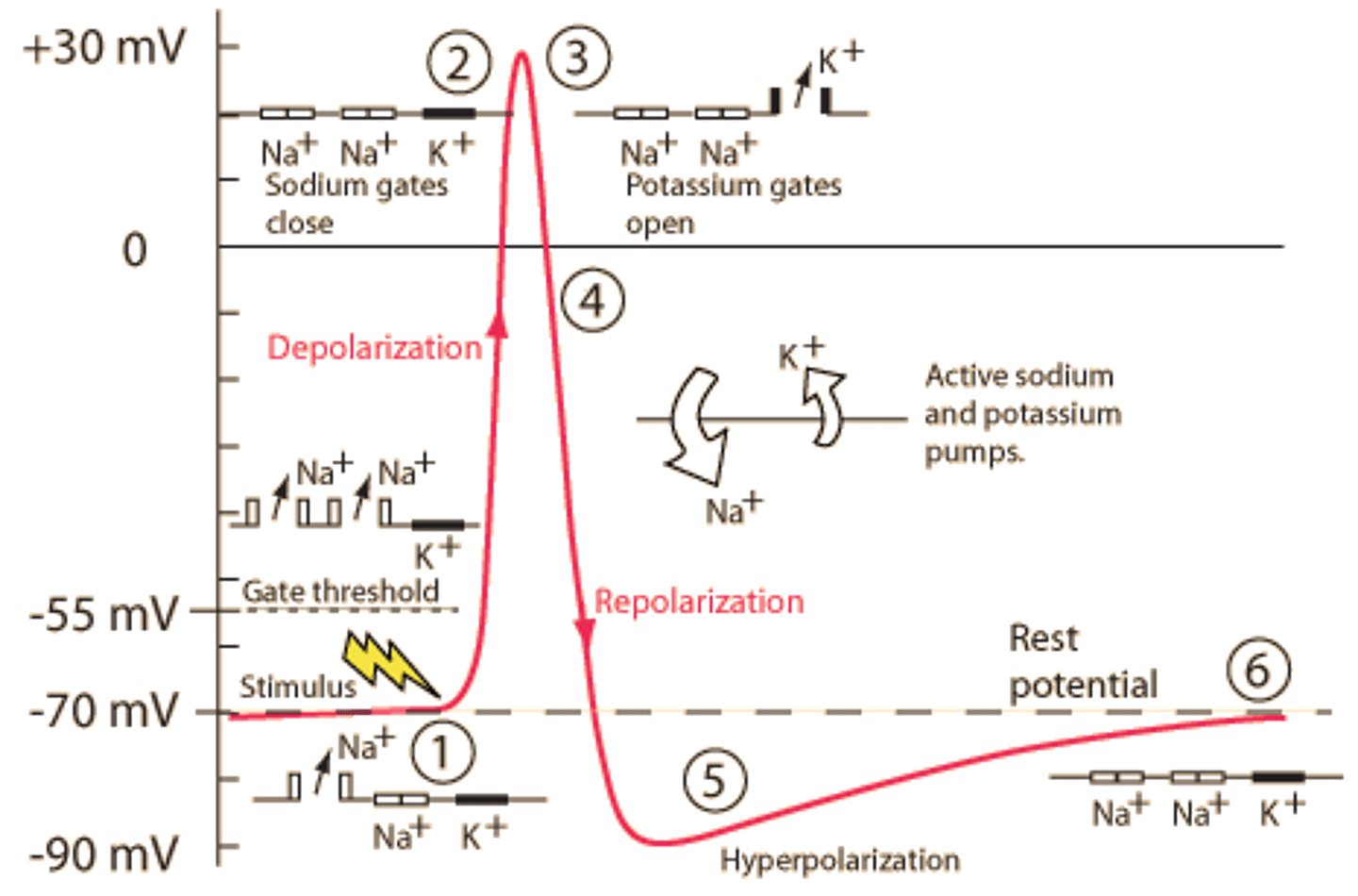
Depolarization
when stimulated Na+ channels open and (+) ions rush in (eliminates the polarization/negative charge within the cell); each Na+ channel across the axon triggers nearby Na+ channels to open as well; -70mV (resting potential) to +40; fires action potential at approx. -60mV
Repolarization
Return of the cell to resting potential, caused by reentry of K+ into the cell while Na+ is pumped out; fixes/resets chemical gradient to prep for another action potential
Saltatory conduction
Rapid transmission of a nerve impulse along an axon, resulting from the action potential jumping from one node of Ranvier to another, skipping the myelin-sheathed regions of membrane.

Acetylcholine (Ach)
Important neurotransmitter between motor neurons and voluntary muscles
Dopamine
regulates motor behavior, MOTIVATION, PLEASURE, and emotional arousal; reward system
Serotonin
plays a primary role in regulating sleep and wakefulness and eating behavior; affects emotional processing; depression
Agonist
chemical that enhances or mimics the action of a neurotransmitter; (e.g. SSRIs)
Antagonist
chemical that blocks the action of a neurotransmitter; (e.g. botox is an Ach Antagonist, stops the movement of muscle)
Sensation
physical processing of environmental stimuli by the sense
Perception
psychological process of INTERPRETING sensory information; affected by absolute threshold; can be lots of variation (Yanny vs. Laurel)
Psychophysics
the study of relationships between the physical characteristics of stimuli, such as their intensity, and our psychological experience of them; FETCHENER
1.) Absolute Threshold
the SMALLEST amount of stimulation needed for detection by a sense 50% OF THE TIME
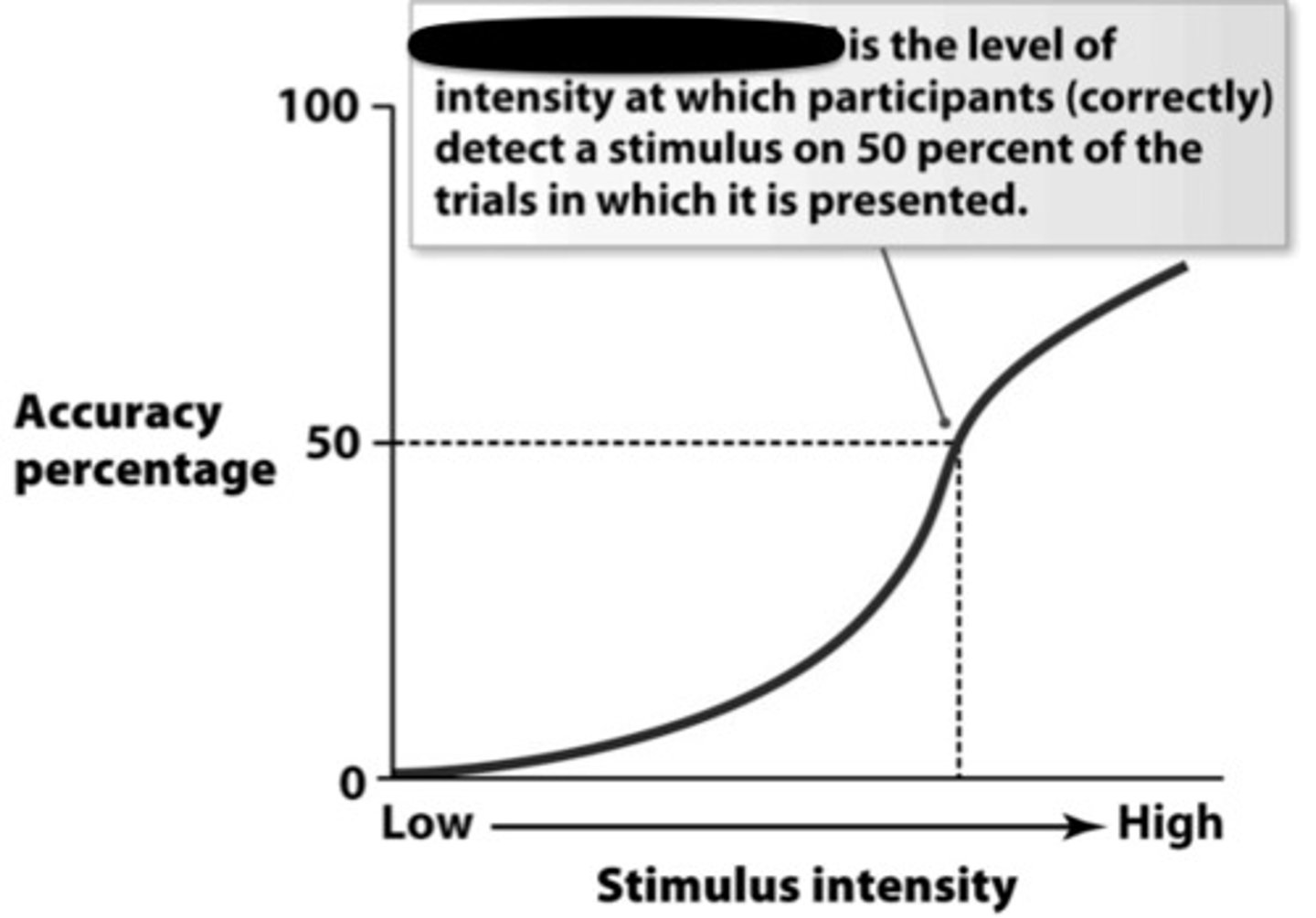
1.) Just Noticeable Difference (JND)
the MINIMUM DIFFERENCE between two stimuli needed to detect the difference between them 50% of the time; more intense original stimulus = more needed to detect the difference between the two; Weber's Law (JND = (delta)I; (delta)I / I = K) K = constant proportion
Things that Affect Perception (6)
1.) Absolute threshold/JND, 2.) signal detection, 3.) top-down/bottom-up processing, 4.) sensory adaptation, 5.) selective attention (inattention blindness, change blindness), 6.) subliminal perception
2.) Signal Detection
response to a stimulus depends on person's sensitivity (abs. threshold) and on a person's decision criteria (person's XPs, expectations, motivation, level of fatigue, consequences of missing stimulus presence)
3.) top-down processing
when our perceptions are influenced by our EXPECTATIONS or by our prior knowledge
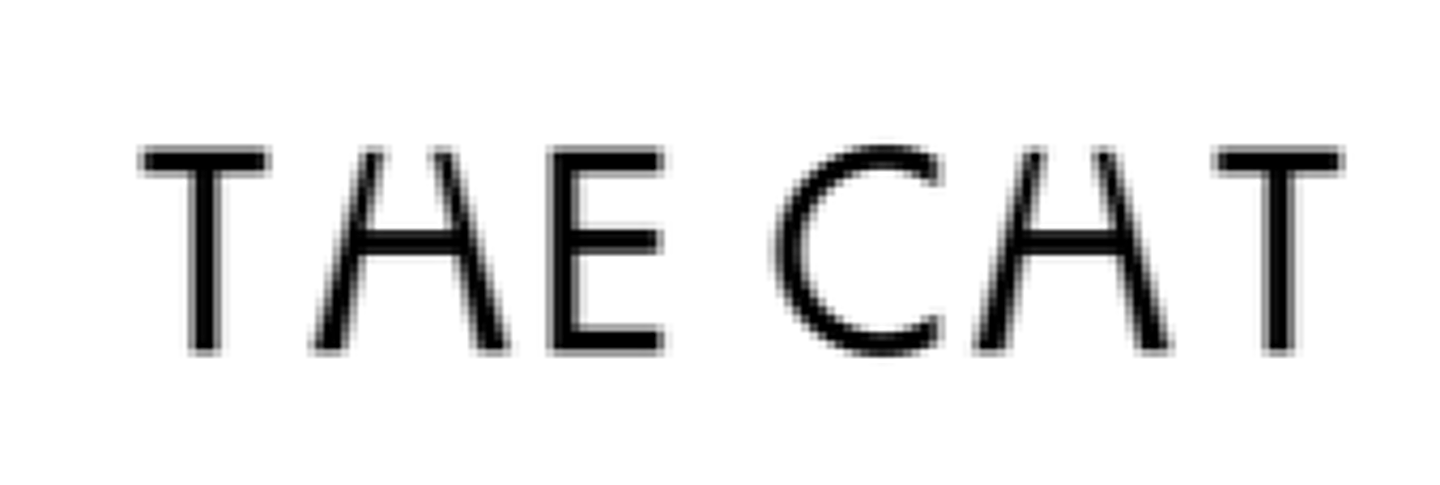
3.) bottom-up processing
occurs when we perceive individual bits of sensory information (e.g. sounds) and use them to construct a more complex message; ex: kids learning to read, read words letter by letter and piece it together
4.) Sensory Adaptation
diminished sensitivity as a result of constant or recurring stimuli; ex: don't feel your leg on your pants all day, water feels cold initially but you get used to it; important because it keep you attentive to CHANGES in environment (evolutionary advantage)
5.) Selective attention - Inattentional Blindness
a failure to perceive OBJECTS that are not the focus of attention; missing the entire object
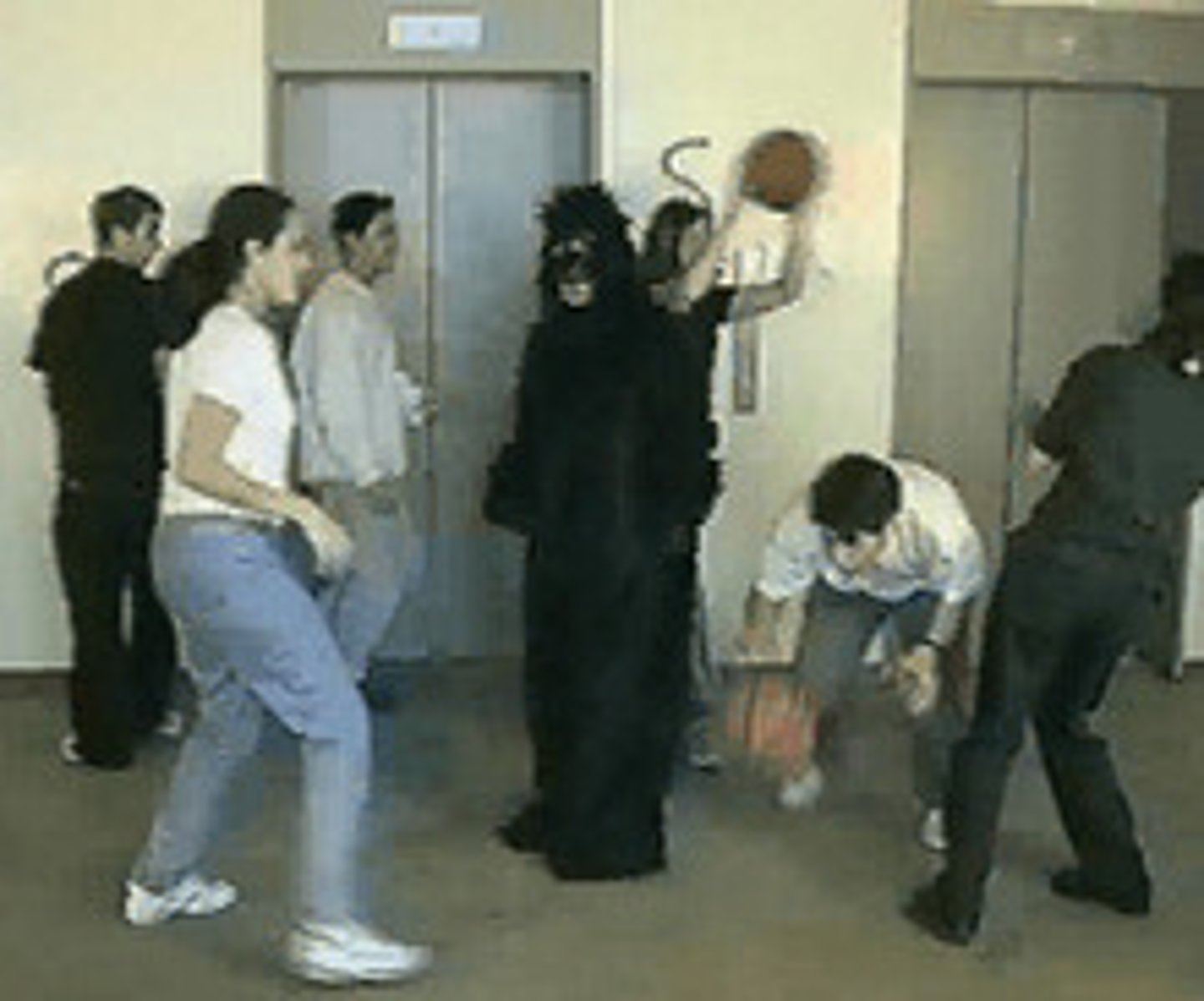
5.) Selective Attention - Change blindness
the failure to detect CHANGES to the visual DETAILS of a scene

6.) Subliminal Perception
the registration of sensory input without our CONSCIOUS awareness; often used in advertising, etc.; Ex: George Bush RATS
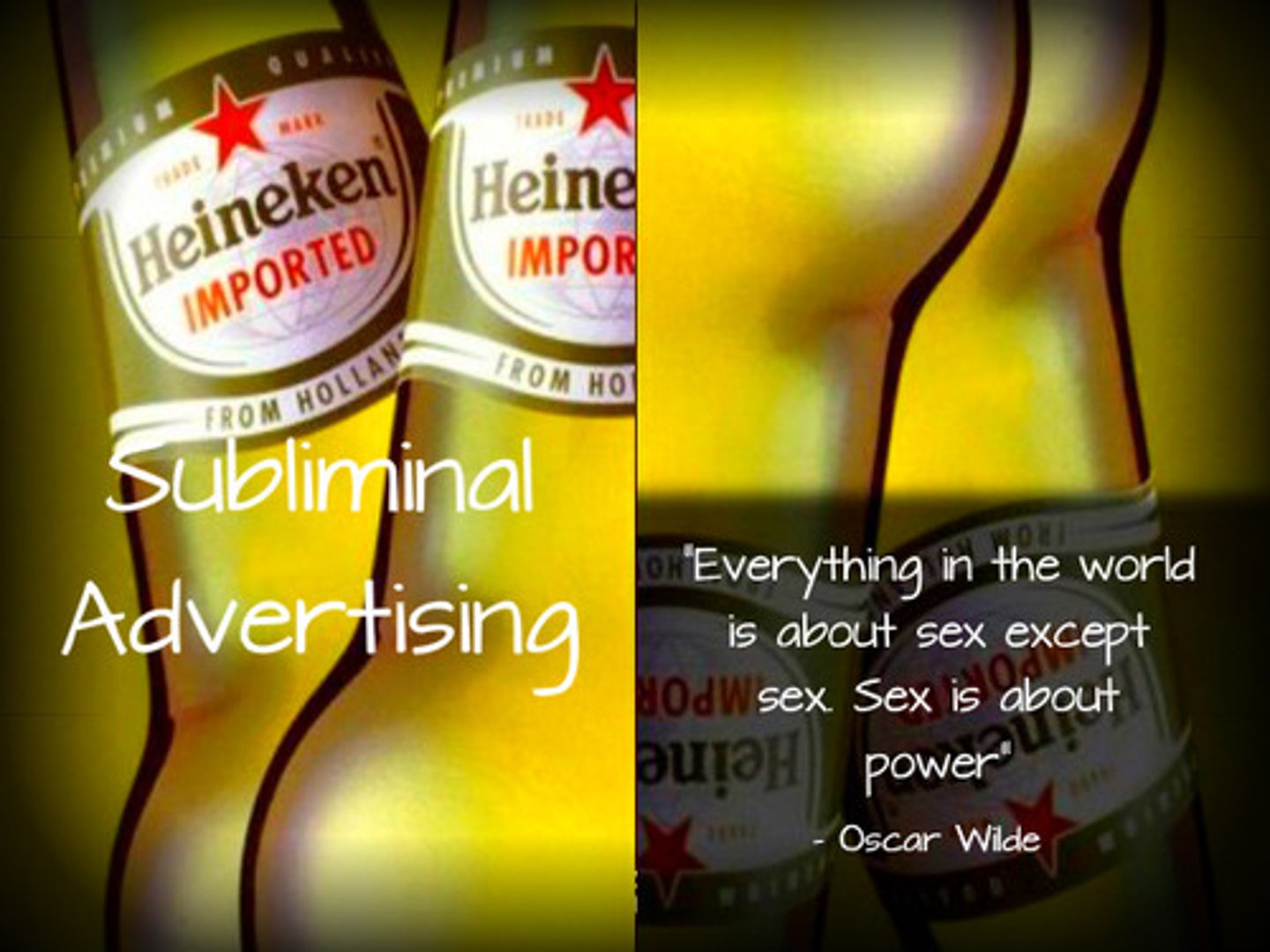
Transduction
conversion of physical stimuli to neural signals
Trichromatic Color Theory
3 different CONES, each sensitive to different wavelengths of light (short, medium, long = blue, green, red); missing one of the cones = color blindness; fails to explain negative after-images; NOT in opposition to Opponent Process; PHOTOTRANSDUCTION
Opponent Process Theory
occurs in PRIMARY VISUAL CORTEX; we perceive color in terms of paired opposites - red v. green, yellow v. blue, and white v. black; explains negative after-images (cells stimulated by red are inhibited by green, when red no longer perceived a rebound effect occurs - the previously inhibited cells are free to fire; NOT in opposition to Trichromatic
Path of Light through the eye
cornea, pupil, lens, RETINA, optic nerve (TRICHROMATIC COLOR THEORY = TRANSDUCTION), thalamus, Primary Visual Cortex (Occipital Lobe) (OPPONENT PROCESS THEORY + Feature Detector Neurons)
Two routes of processing of visual stimuli
DORSAL ("where" pathway) - occipital -> parietal; visually guided movement, VISUAL-SPACIAL processing; VENTRAL ("What" pathway) - occipital -> temporal; IDENTIFICATION of objects, faces, etc.

Monocular Depth Cues
help us perceive depth using only one eye; e.g. light + shadow, linear perspective/convergence of lines (railroad), relative size + height, interposition (objects in front/behind each other)
Binocular Depth Cues
clues about distance based on the differing views of the two eyes; further = less retinal disparity, closer = more retinal disparity
Keeping precept constant despite different visual outputs (2)
1.) SIZE CONSTANCY: understand that objects appear small when further away, don't think it just shrunk, 2.) BRIGHTNESS CONSTANCY: understand that shadow/darkness affects color
Pinna (outer ear)
visible part of ear that helps to collect sound and direct towards eardrum

Auditory canal (outer ear)
transmits sound from the pinna to the eardrum

Eardrum (outer ear)
membrane that vibrates when sound hits it; amplifies the sound
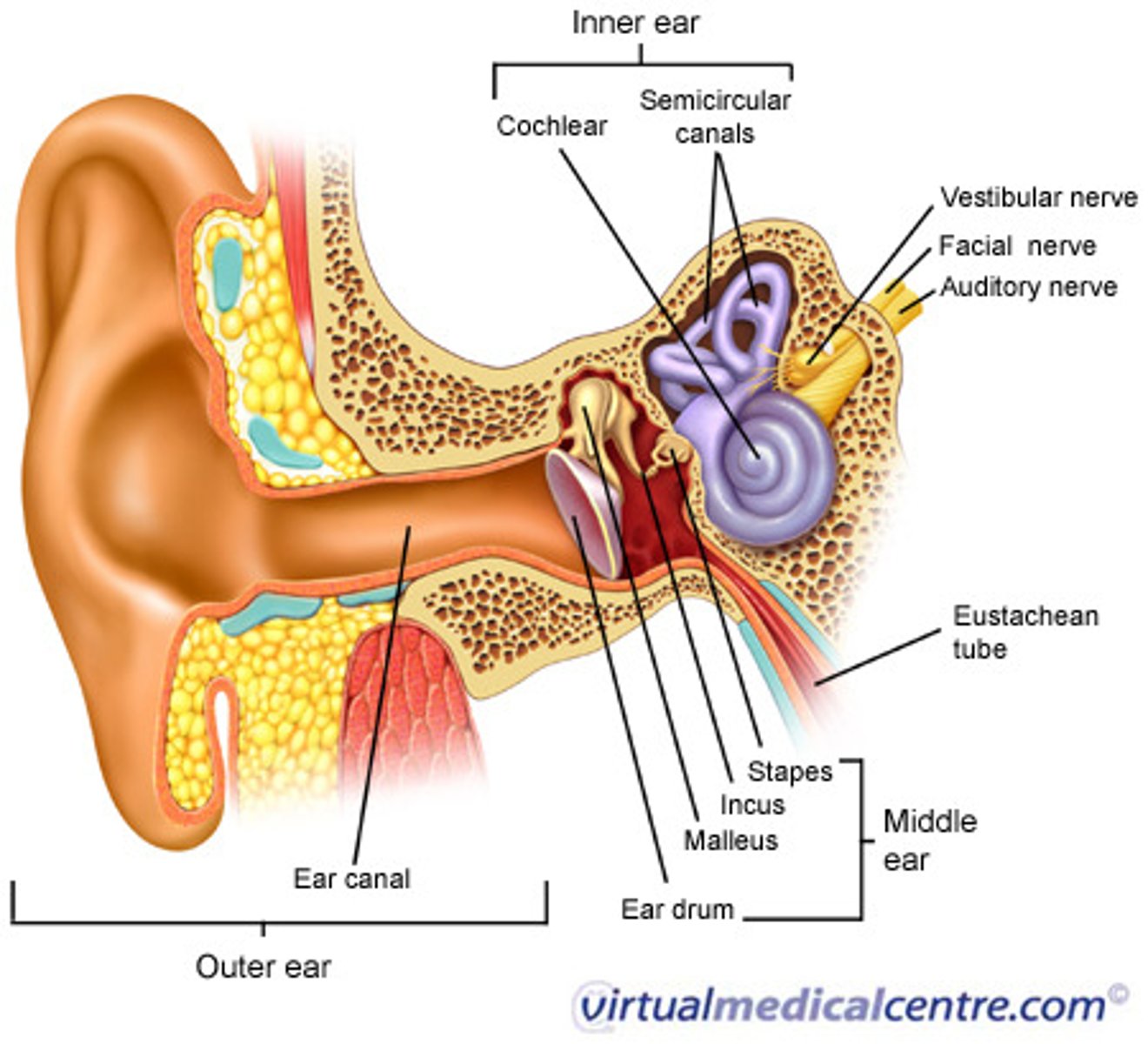
Ossicle bones (middle ear)
hammer, anvil, stirrup; AMPLIFY signals from eardrum into the ear

Cochlea (inner ear)
fluid-filled membrane and vibrating hair cells that vibrate to different frequences; TRANSDUCTION of sound
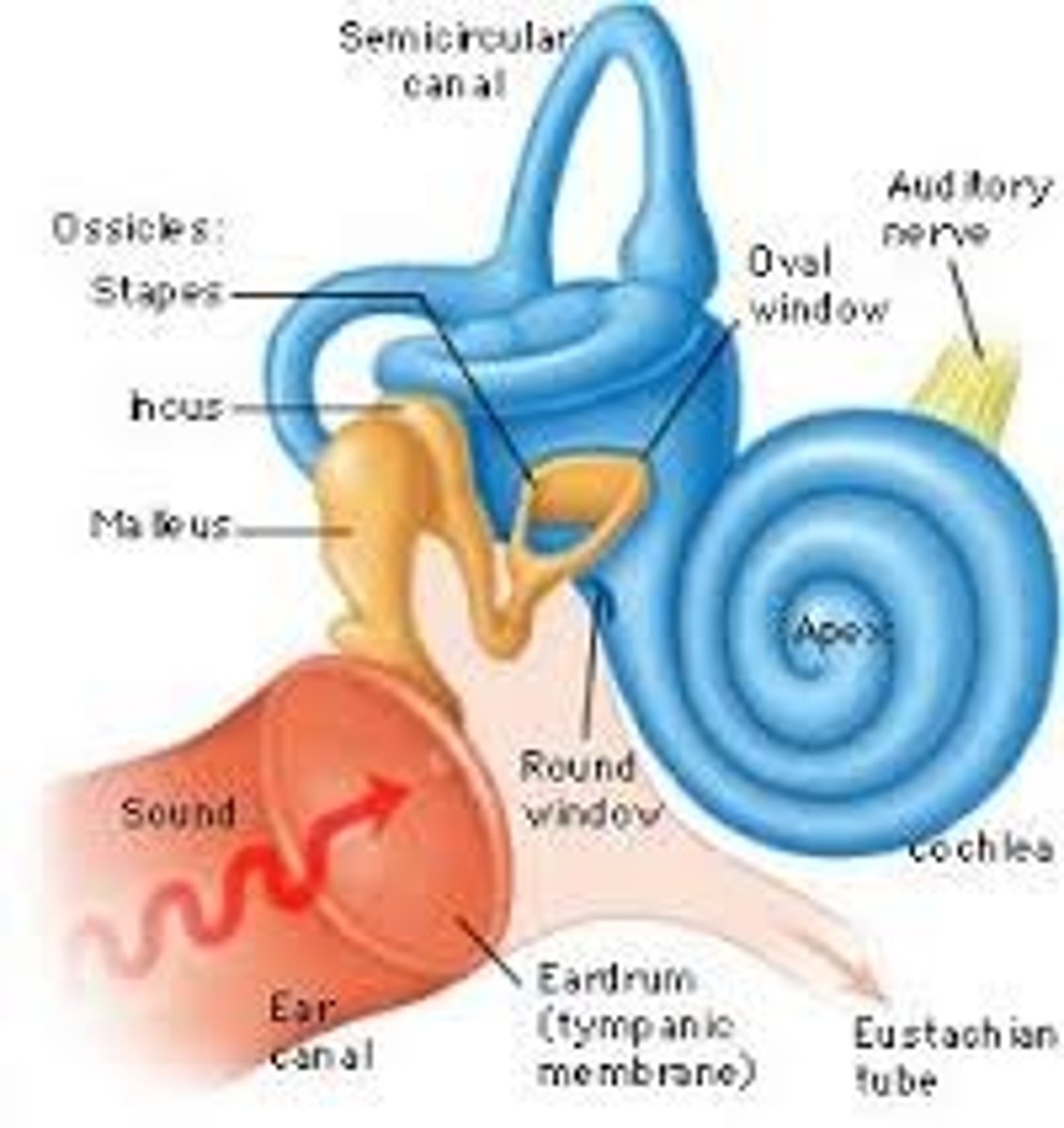
Sources of Hearing Loss
1.) CONDUCTIVE HEARING LOSS - Damage to eardrum (outer) or ossicles (middle) causes sound to not be amplified enough; fixed with hearing aid 2.) SENSORY NEURAL - damage to cochlea (inner ear) or auditory nerves, TRANSDUCTION interrupted, fixed with cochlear implant (esp. in kids)
Sound Localization
detecting where in space a sound is coming from (bc distance between ears = different timing)
Multimodal Perception
The effect that concurrent stimulation in more than one sensory modality has on the perception of events and objects in the world; integration ACROSS THE SENSES; (ex: McGurk Effect: hear things differently based on what you're looking at)
Synaesthesia
condition in which perceptual or cognitive activities (i.e. listening to music/reading) triggers exceptional sensory experiences; theory: all babies have synaesthesia, some people have remnants of those neural connections that BLEND THEIR SENSES still; (e.g. violin player who sees flashes of light with each note)
Classical Conditioning
Ivan Pavlov (1906); based on stimulus-response (behaviorism); BIOLOGICALLY driven (involuntary) responses; NO COGNITIVE COMPONENT; dog salivation triggered by what should have been a neutral stimuli (presence of person/bell rung = associative learning); unconditioned stimulus = unconditioned response is natural, no conditioning necessary (e.g. food = dog salivation)

Classical Conditioning Response: Unconditioned Response and Conditioned response are the _____ response triggered by ______ events
same response, different events (e.g. dog salivation)
Classical Conditioning Stimuli: Neutral Stimulus and Conditioned Stimulus are the ______ stimulus, the difference is whether the stimulus triggers the _______
same stimulus, triggers the conditioned response or not (e.g. the bell rung)
Acquisition Phase of Classical Conditioning
the more the association/conditioning with the Neutral Stimulus (bell) is reinforced/repeated, the stronger the Conditioned Response (salivation) will be
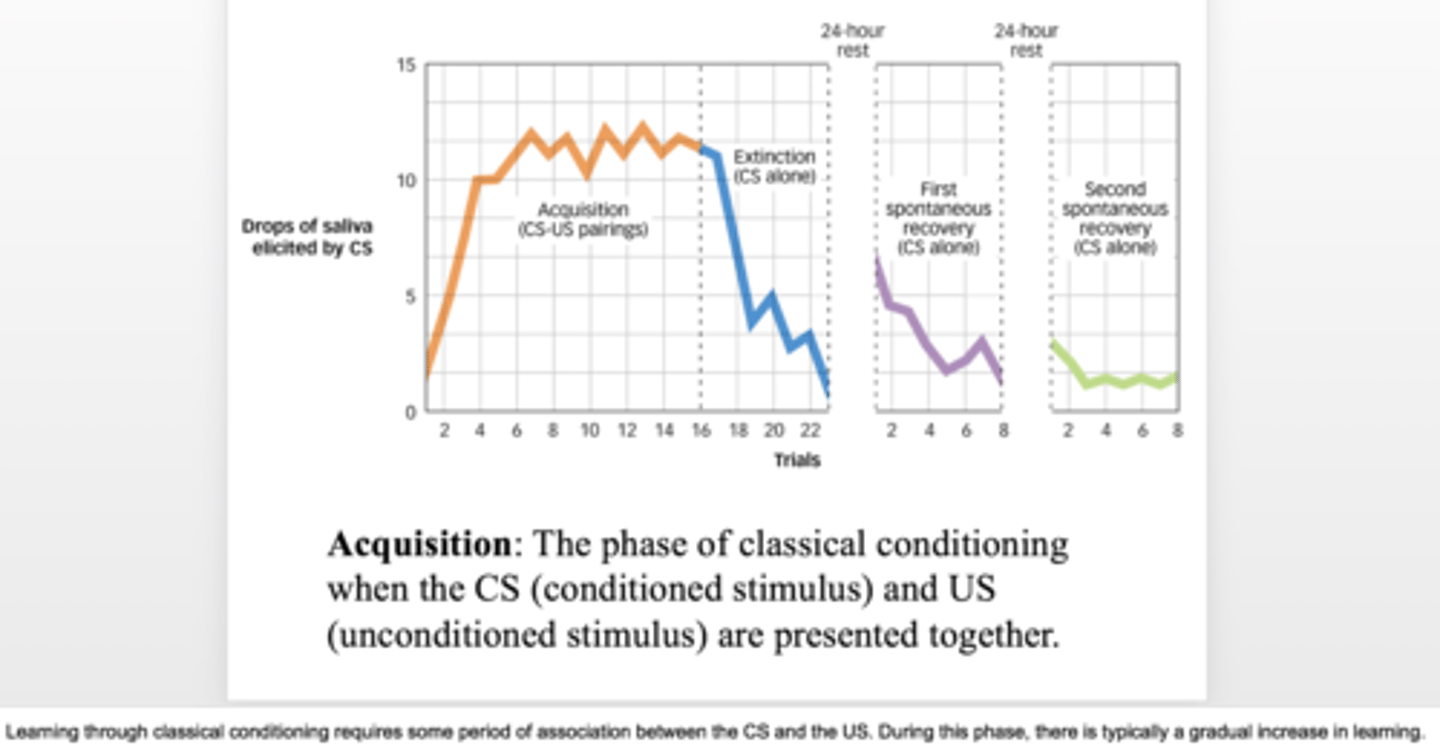
Extinction Phase of Classical Conditioning
If the Conditioned Stimulus (bell) is repeatedly presented WITHOUT the Unconditioned Stimulus (food)
Spontaneous Recovery
if dog stopped responding and you remove it from the room, when bringing it back and ringing bell, might show response again SPONTANEOUSLY
generalization (classical conditioning)
once a response has been conditioned, similar stimuli can elicit the same response (e.g. different bell tones still produce salivation)
discrimination (classical conditioning)
ability to distinguish between similar but distinct stimuli (e.g. if dog shows LESS salivation to a different bell tone)
John Watson's Little Albert Experiment
application of Classical Conditioning to Humans; baby conditioned to fear rat, generalized fear to rabbits as well; showed it was possible to condition complex reactions like fear using Pavlovian techniques
Little Peter Experiment
Little peter was afraid of rabbits. Jones used food as the pleasant stimulus. The food and the rabbit became associated which led to Little Peter to be LESS AFRAID of the rabbit while it was moved closer to him. Little Peter became confident around the rabbit that he was able to pet the rabbit WITHOUT FEAR
What affects classical conditioning
1.) PREPAREDNESS (an organism's EVOLUTIONARY HISTORY can make it easier to learn particular associations; e.g. humans more likely to associate illness with food than lights, sound) 2.) FAMILIARITY/EXPECTATIONS (explains why Pavlov himself didn't become a Conditioned Stimulus (too familiar), e.g. more likely to associate food poisoning with Novelty Food than food you eat All The Time)
Conditioned Taste Aversions
The avoidance of food as response to illness. can have a LONGER DELAY than most stimulus-response patterns, only takes ONE TRIAL/XP
Operant Conditioning
Skinner; a type of learning in which an individual's behavior is modified by its CONSEQUENCES (either favorable or unfavorable); subjects learn to modify something (e.g. kid in class to pick up water bottle)

Edward Thorndike's Law of Effect
Behaviors followed by FAVORABLE consequences become MORE LIKELY, behaviors followed by UNFAVORABLE consequences become LESS LIKELY

Reinforcement
INCREASES likelihood of the behavior occurring again; POSITIVE = giving something LIKED to inc. behavior, NEGATIVE = taking something away that is disliked to inc. behavior
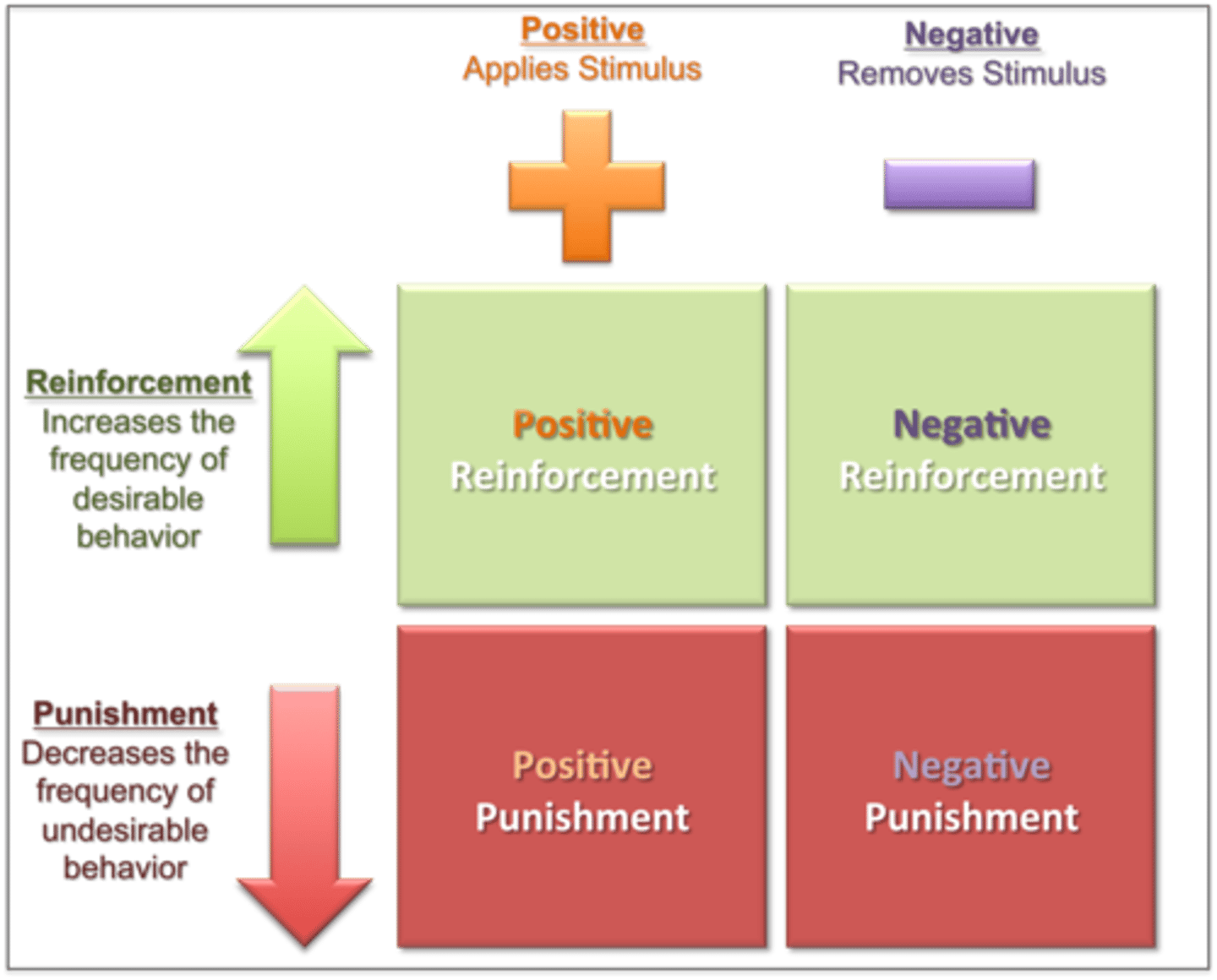
Punishment
DECREASES likelihood of the behavior occurring again; POSITIVE = giving something DISLIKED to dec. behavior, NEGATIVE = taking something LIKED to dec. behavior

Shaping
gradually modifying an animal's behavior through a series of successive approximations of the target behavior
Partial/intermittent reinforcement vs. continuous reinforcement
behaviors conditioned using partial/intermittent reinforcement resist extinction longer than those that were conditioned under continuous reinforcement
fixed reinforcement schedule
reinforcement after a GIVEN/FIXED AMOUNT of time or responses

variable reinforcement schedule
reinforcement after an AVERAGE AMOUNT of time has passed or responses have been given; reinforcement is UNPREDICTABLE
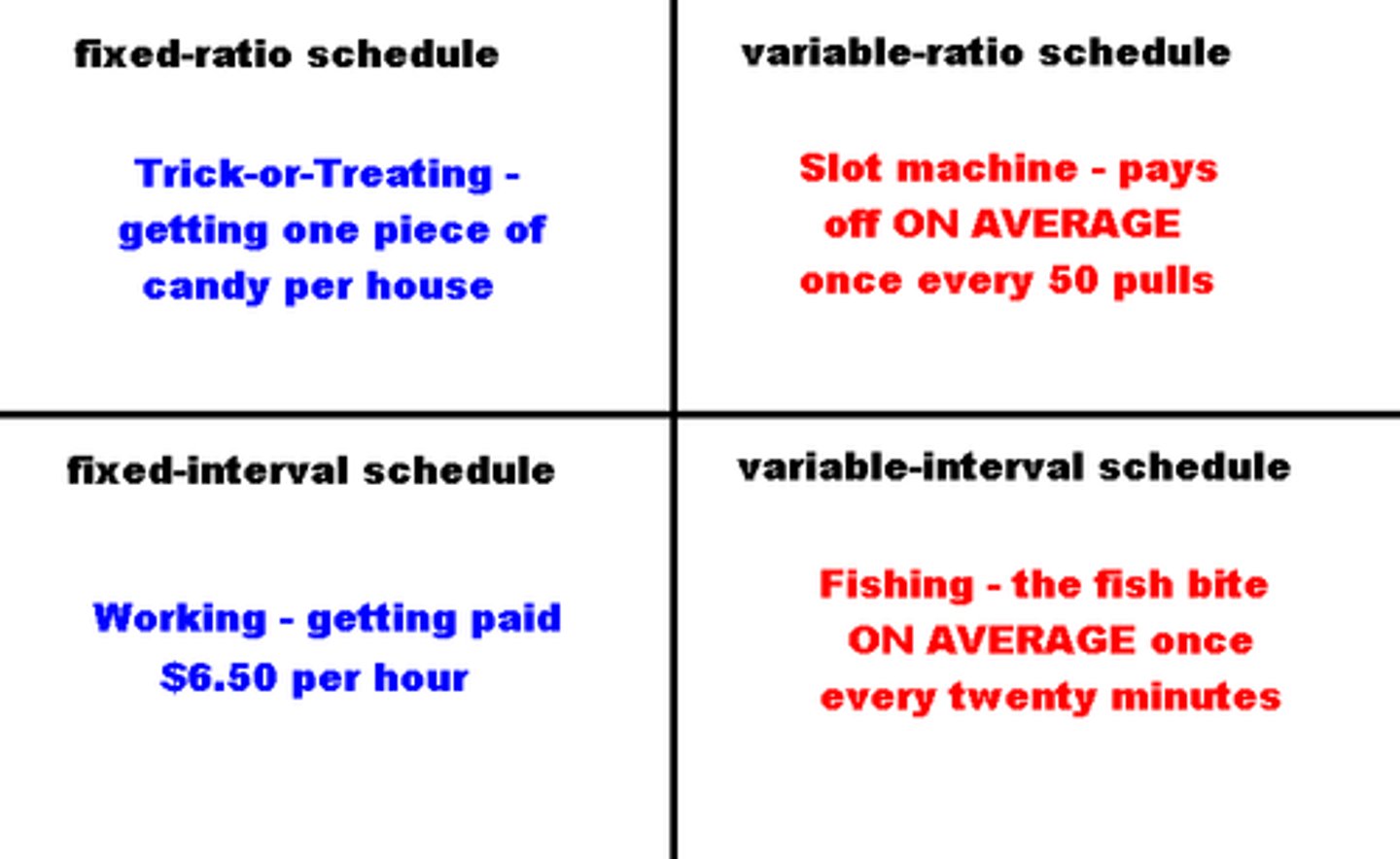
INTERVAL Schedule of Reinforcement
based on TIME intervals
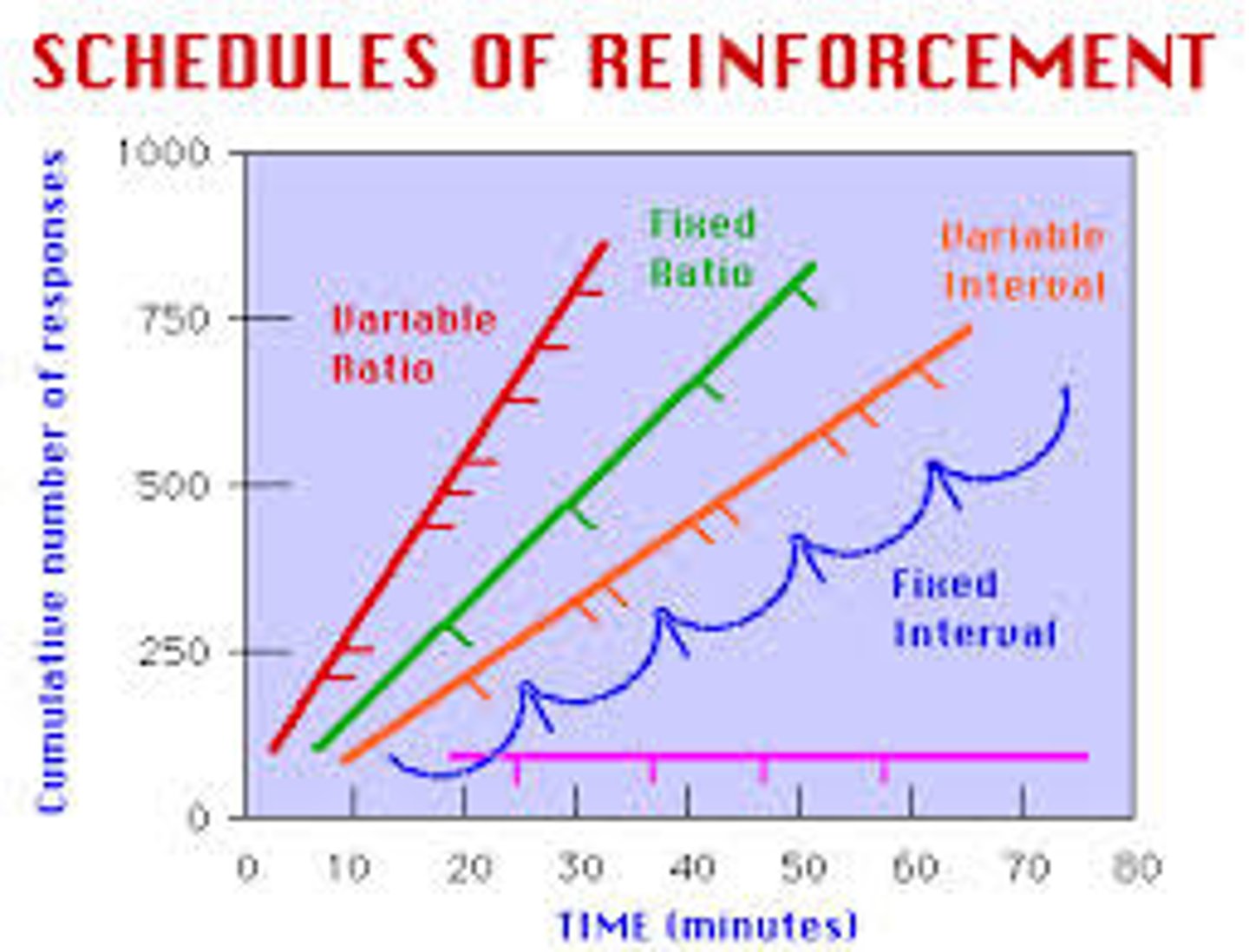
RATIO Schedule of Reinforcement
based on NUMBER OF BEHAVIORS/RESPONSES
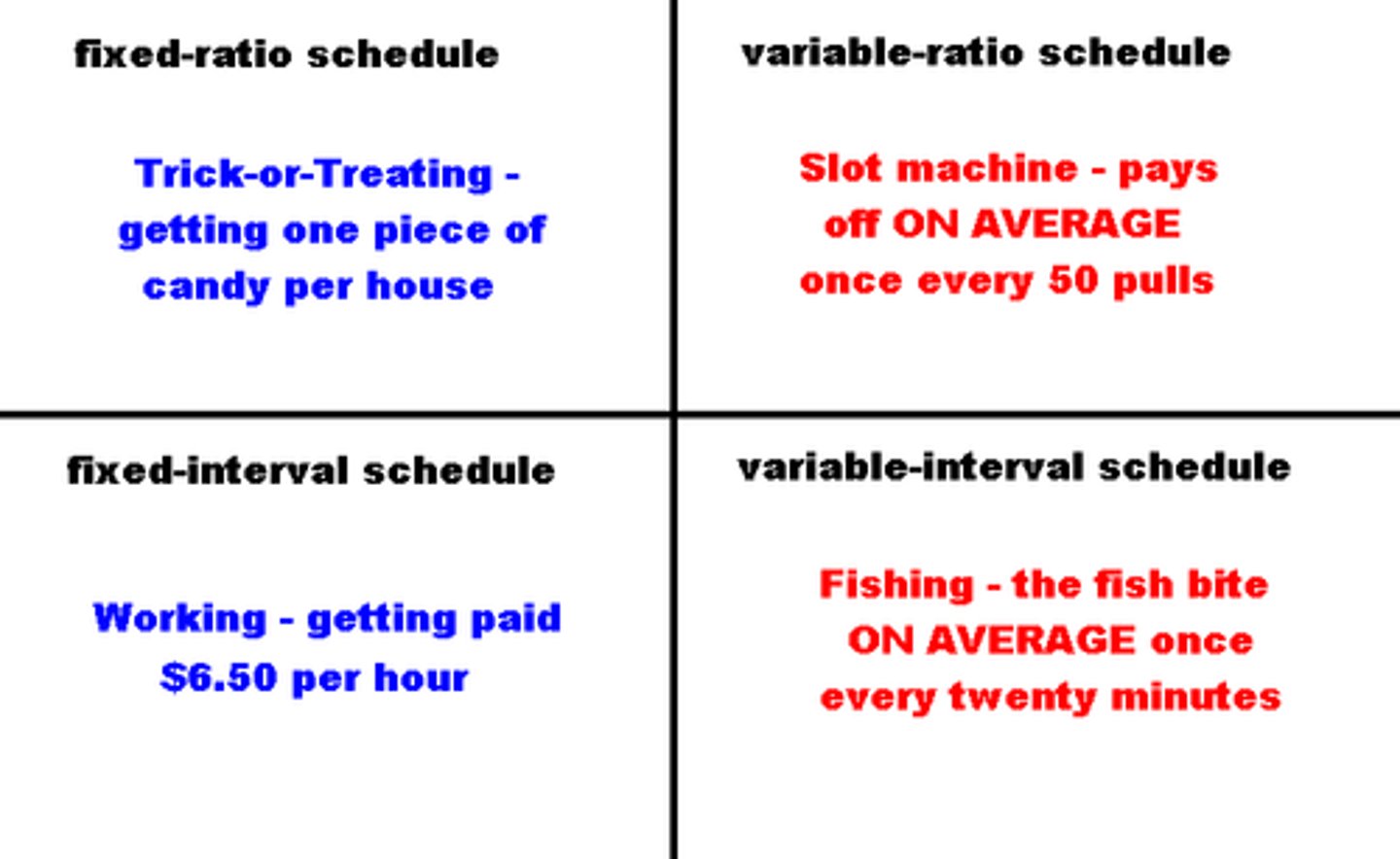
Which reinforcement schedule is MOST resistant to extinction?
VARIABLE RATIO
Why are rewards rewarding?
Nucleus accumbens (basal ganglia) is activated during the process of rewards; DOPAMINE is released when a behavior is REWARDED for the FIRST TIME; genetic variation in dopamine and dopamine circuits can explain individual differences
Observational learning
an organism learns from watching others (e.g. BoBo doll experiment)
Latent Learning
even WITHOUT reward, rats naturally explore and learn about maze (can't be explained by strict behaviorism)